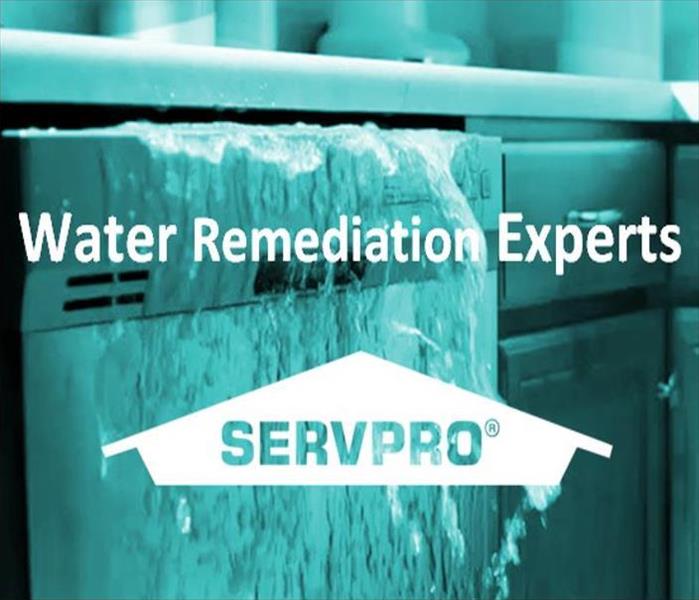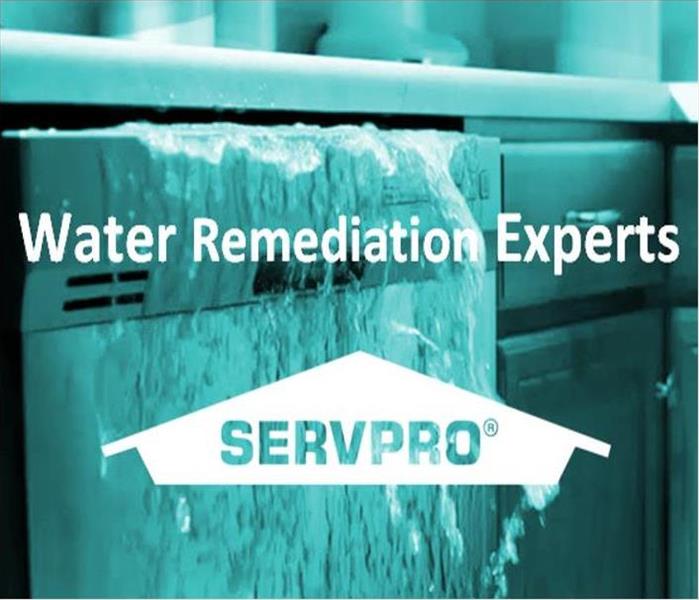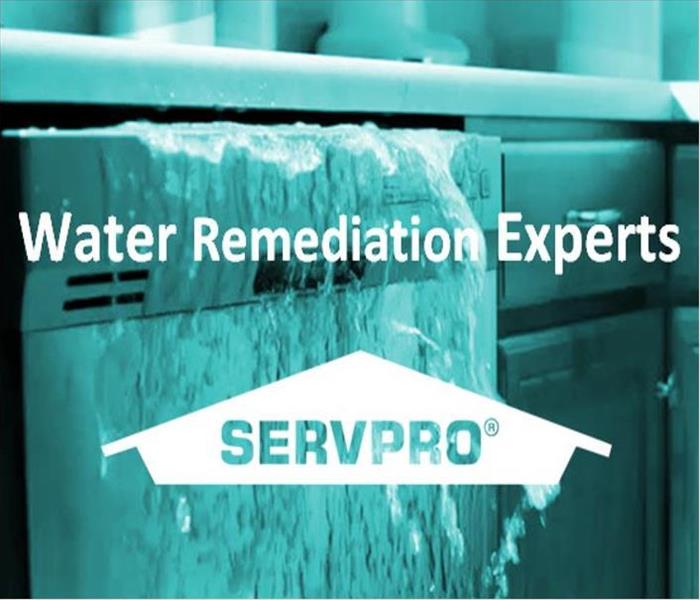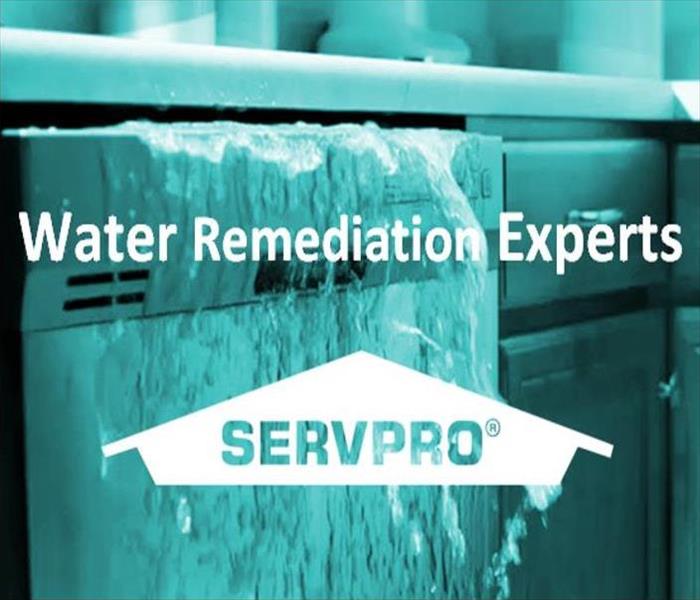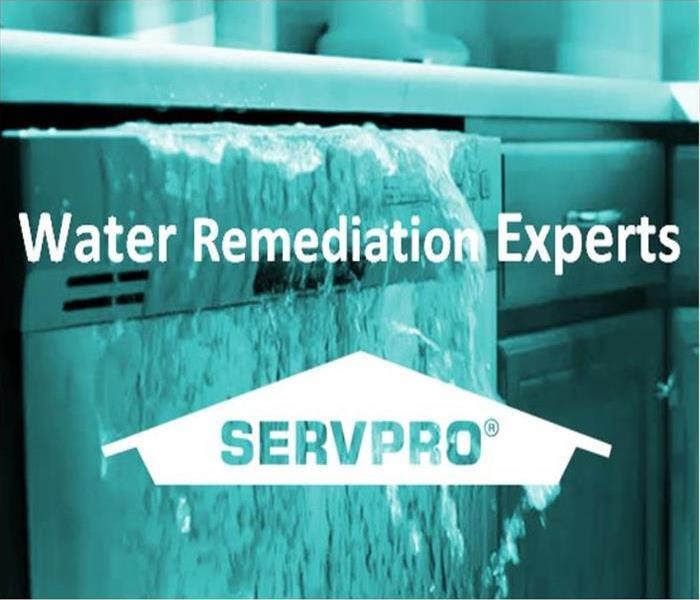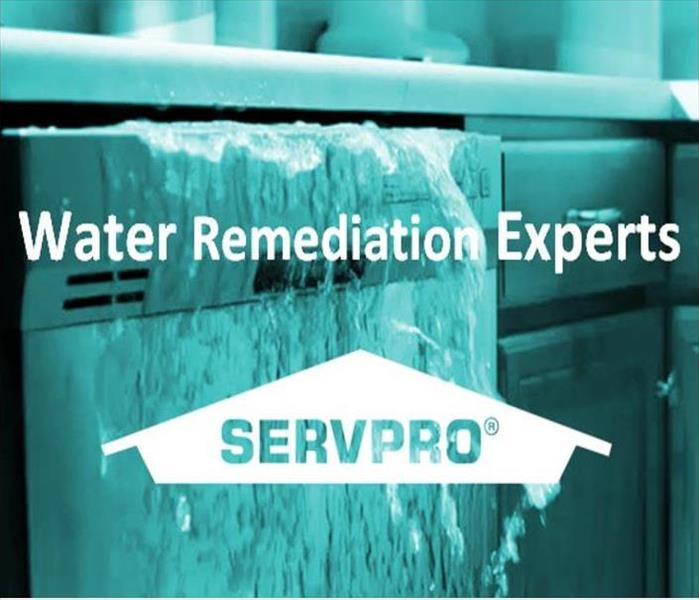Recent Water Damage Posts
Top 5 Reasons to Call Us After Water Damage
1/1/2025 (Permalink)
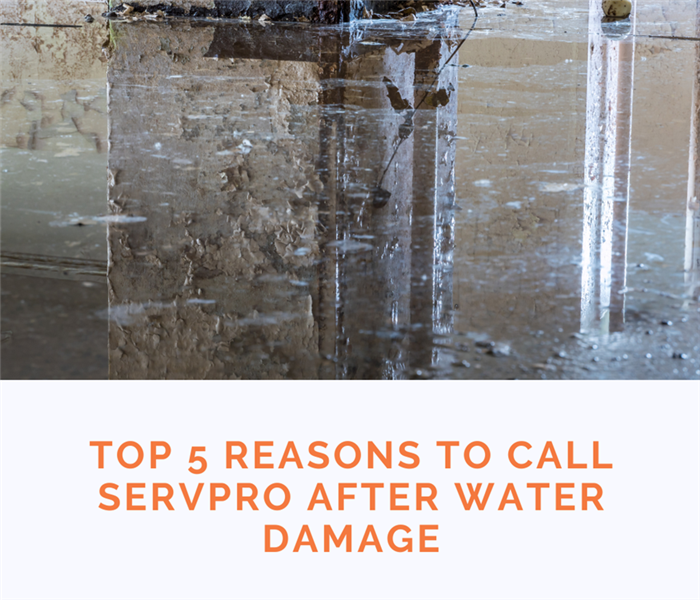 Water damage can happen without warning, leaving your home or business at risk of serious and lasting harm if not addressed quickly.
Water damage can happen without warning, leaving your home or business at risk of serious and lasting harm if not addressed quickly.
Water damage can happen without warning, leaving your home or business at risk of serious and lasting harm if not addressed quickly. Here’s why contacting us after water damage is the smartest decision you can make:
1. Quick Action Prevents Mold Growth
Mold can start growing as soon as 24-48 hours after water damage occurs. Our team responds swiftly to minimize damage and stop mold growth before it causes health risks or further property damage.
2. Advanced Water Removal and Drying Equipment
We use cutting-edge technology to thoroughly remove water from your property. Our powerful pumps and specialized drying equipment can extract moisture even from hidden areas, such as behind walls and beneath floors, reducing the risk of ongoing structural issues.
3. Experienced Restoration Professionals
With years of expertise in water damage restoration, our highly trained specialists can handle every situation, from small leaks to large-scale flooding. You can trust us to restore your property safely, efficiently, and with care.
4. Support for Insurance Claims
Dealing with insurance claims after water damage can be overwhelming. We simplify the process by working directly with your insurance provider, providing detailed documentation and expert guidance to ensure you get the compensation you deserve.
5. Success Stories You Can Trust
Homeowners and businesses have relied on us to restore their properties after water damage. From saving a flooded basement after a burst pipe to helping a business reopen quickly following storm flooding, our proven results showcase our dedication to excellence.
Don’t let water damage disrupt your life. As a trusted leader in the restoration industry, Natick/Milford has the expertise, advanced tools, and training to restore your property to its pre-damage condition.
Frozen Pipes and Ice Dams: What to Do If You Return to Winter Water Damage
12/10/2024 (Permalink)
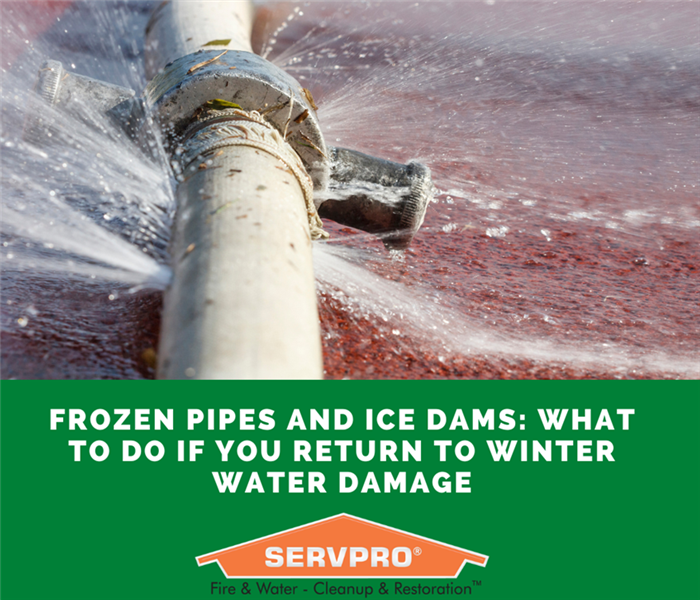 At SERVPRO of Natick, Milford, we have the advanced training and equipment to restore your home or business to its pre-damage condition.
At SERVPRO of Natick, Milford, we have the advanced training and equipment to restore your home or business to its pre-damage condition.
Winter vacations are a wonderful way to relax, but discovering frozen pipes or water damage upon returning home is anything but.
Cold temperatures can lead to frozen pipes and ice dams, which often result in leaks and costly repairs if left unaddressed. Here’s what you need to know to identify, address, and prevent these winter hazards in your home.
1. Understanding the Risks: Frozen Pipes and Ice Dams
- Frozen Pipes: When water in your pipes freezes, it expands, potentially causing cracks or bursts. As the ice melts, water can flood the area, leading to significant damage.
- Ice Dams: Ice dams form when melting snow refreezes at your roof’s edge, creating a barrier. This trapped water can seep into your home, damaging walls, ceilings, and insulation.
2. Recognizing Signs of Damage
Be alert for common indicators of water damage caused by frozen pipes or ice dams:
- Water Stains on Walls or Ceilings: These may signal leaks from melting ice dams.
- Low Water Pressure: Weak faucet flow could mean a frozen pipe is blocking water.
- Pooling Water or Dampness: Look for unexpected moisture near exterior walls, basements, or under sinks.
- Frost on Pipes: In unheated areas like basements or crawl spaces, frost on pipes is a warning sign of freezing.
3. Immediate Actions to Take
If you suspect water damage, acting quickly is critical. Here’s how:
- Shut Off the Water: Turn off the main water supply to prevent further leaks.
- Cut Power to Affected Areas: Avoid the dangerous combination of water and electricity by shutting off power to rooms with flooding.
- Drain Your Pipes: Open faucets to release remaining water and reduce pipe pressure.
- Remove Standing Water: Use towels or a wet-dry vacuum to soak up water, especially on carpets or hardwood floors, to avoid mold growth.
4. Thawing Frozen Pipes Safely
If pipes are frozen but not burst, thaw them gradually:
- Apply Heat: Use a space heater, hair dryer, or heating pad. Avoid open flames or extreme heat, which could damage pipes.
- Start with Exposed Pipes: Begin thawing pipes you can easily access and work your way to harder-to-reach areas.
- Keep Faucets Open: A trickle of water through faucets can speed up thawing and encourage flow.
5. Addressing Ice Dam Damage
Ice dams can cause water to seep through your roof and down your walls, creating hidden damage:
- Check Attic Insulation: Wet or damaged insulation often signals ice dam problems. Replace it to prevent mold growth.
- Inspect Walls and Ceilings: Look for damp spots or discoloration and address them promptly to prevent further damage.
- Use a Dehumidifier: Dry out walls or ceilings with a dehumidifier after removing standing water.
6. When to Call the Experts
While minor issues can be handled yourself, professional help is recommended when:
- Significant flooding or water damage is beyond your ability to clean up.
- Mold growth has begun.
- Water has infiltrated electrical systems or insulation, creating safety hazards.
Trained professionals use advanced tools like moisture meters, industrial fans, and dehumidifiers to ensure thorough and efficient restoration.
7. Preventing Future Winter Water Damage
Protect your home from frozen pipes and ice dams with these proactive measures:
- Insulate Pipes: Wrap exposed pipes with foam or insulation tape.
- Drip Faucets: Keep faucets slightly open during extreme cold to prevent freezing.
- Maintain Attic Insulation: Proper insulation keeps your attic cold, preventing snowmelt from refreezing.
- Clear Gutters: Ensure gutters are free of debris so melting snow drains properly.
8. Prepping Your Home Before Winter Trips
Take these precautions before leaving for a winter vacation:
- Set Your Thermostat: Keep your home at a minimum of 55°F to avoid freezing.
- Shut Off Water Supply: If possible, turn off the main water valve and drain pipes before you leave.
- Open Cabinet Doors: Allow warm air to circulate around pipes in unheated areas.
Returning home from a winter getaway to discover water damage can be overwhelming, but acting quickly can turn a potential disaster into a manageable issue. By recognizing the signs of damage, taking immediate steps, and following preventive measures, you can safeguard your home against winter’s risks.
At SERVPRO of Natick, Milford, we have the advanced training and equipment to restore your home or business to its pre-damage condition.
Dealing with Residential Water Damage: What You Need to Know and Do Next
11/20/2024 (Permalink)
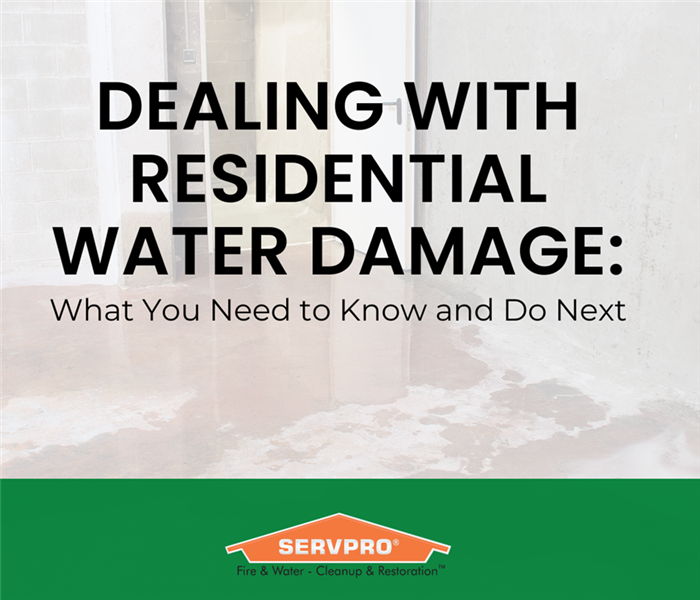 As a trusted leader in the restoration industry, SERVPRO of Natick/Milford has the expertise and advanced equipment needed to restore your home or bus
As a trusted leader in the restoration industry, SERVPRO of Natick/Milford has the expertise and advanced equipment needed to restore your home or bus
Water damage in your home can happen without warning—whether from a burst pipe, flooding, or a roof leak.
No matter the cause, water damage can lead to significant problems like structural issues, mold growth, and loss of personal belongings. Acting quickly is essential to minimize damage and begin the restoration process. Here’s a step-by-step guide to handling residential water damage and understanding the importance of professional restoration services.
Step 1: Identify and Stop the Water Source
The first step in addressing water damage is to locate and stop the source of water intrusion. If the issue stems from a burst pipe, shut off your main water supply. For external problems, such as a broken water main, contact your utility provider. In cases of flooding from natural disasters, wait until the water recedes and ensure the area is safe before entering.
Step 2: Assess the Damage
Once it’s safe, evaluate the extent of the water damage. Water can seep into walls, floors, and ceilings, often causing hidden problems. Mold can begin developing within 24-48 hours, so prompt action is critical. Take photos and document the damage for your insurance claim. Depending on the severity, professional assessment may be necessary to uncover unseen issues.
Step 3: Notify Your Insurance Provider
Contact your homeowner’s insurance company to report the damage and begin the claims process. Provide detailed documentation, including photos and estimates for repairs. Keep records of any related expenses, such as temporary housing, repairs, or item replacements, as these might be reimbursable under your policy.
Step 4: Remove Water and Dry the Area
Standing water can cause additional structural damage and create ideal conditions for mold growth. Professionals use specialized equipment, such as high-powered pumps, vacuums, and industrial fans, to extract water and dry affected areas efficiently.
- Carpets and Flooring: Soaked carpets often need removal and drying or replacement. Wood floors may swell or warp and require professional treatment to restore.
- Drywall and Insulation: Wet drywall typically needs to be cut out and replaced to prevent mold. Damaged insulation loses effectiveness and can become a health hazard, so it should be removed and replaced.
Step 5: Prevent Mold Growth
Mold can develop in hidden areas like behind walls, under floors, or inside insulation. Its spores can spread quickly, posing health risks to your family. Professional restoration teams use advanced tools, such as moisture meters and antimicrobial treatments, to detect and eliminate hidden moisture and prevent mold growth.
Step 6: Restore and Repair
Once the water is removed and the area is dry, begin the restoration process. Depending on the extent of the damage, this may include:
- Replacing drywall, flooring, and insulation
- Repairing or replacing damaged cabinetry, furniture, and fixtures
- Restoring personal items like electronics, clothing, and documents
Professional restoration experts can guide you through these repairs to ensure your home is safe and fully restored.
Step 7: Take Preventive Measures
After restoration, take proactive steps to reduce the risk of future water damage. Regularly inspect areas prone to leaks, such as roofs, windows, and plumbing. Consider installing a sump pump if you live in a flood-prone area and waterproof your basement to provide additional protection.
Don’t Delay—Act Fast
Water damage can be overwhelming, but quick action can minimize its impact and reduce repair costs. Identifying the source, removing water promptly, and working with restoration professionals can save your home from long-term issues like mold and structural damage.
If your home has experienced water damage, don’t wait. Contact our water damage restoration team today for prompt, reliable service to help you recover safely and efficiently.
As a trusted leader in the restoration industry, SERVPRO of Natick/Milford has the expertise and advanced equipment needed to restore your home or business. Call us at (774) 290-4300 to get started.
How to Protect Your Home from Heavy Rainfall and Flooding in Milford, MA
8/21/2024 (Permalink)
 Heavy rainfall and flooding can cause significant water damage to your home, leading to costly repairs and potential health hazards.
Heavy rainfall and flooding can cause significant water damage to your home, leading to costly repairs and potential health hazards.
Heavy rainfall and flooding can cause significant water damage to your home, leading to costly repairs and potential health hazards. Preparing your home for such events involves taking proactive steps to prevent water intrusion. Here’s how you can protect your home from water damage during heavy rainfall and flooding in Milford, MA
Seal Cracks in Foundations
Cracks in your home's foundation are a common entry point for water. Sealing these cracks can prevent water from seeping into your basement or crawl space. Here’s how to do it:
- Inspect Your Foundation: Regularly check your foundation for cracks, especially before the rainy season.
- Use Epoxy or Polyurethane Sealant: Fill small cracks with an epoxy or polyurethane sealant. For larger cracks, consider hiring a professional to ensure a thorough repair.
- Apply Waterproof Coatings: Apply a waterproof coating to your foundation walls to add an extra layer of protection against water intrusion.
Install Sump Pumps
A sump pump is a crucial device for preventing basement flooding. It automatically pumps out water that collects in a sump basin, keeping your basement dry. Here’s what you need to know:
- Choose the Right Pump: Select a sump pump that fits your needs, considering the size of your basement and the amount of water typically encountered.
- Regular Maintenance: Test your sump pump regularly to ensure it’s functioning correctly. Clean the pump and the sump basin to prevent clogs.
- Consider a Backup System: Power outages often accompany heavy storms, so having a battery backup or water-powered backup sump pump can provide additional protection.
Use Sandbags
Sandbags are an effective way to divert water away from your home during heavy rainfall. They can be placed strategically to block water from entering vulnerable areas. Here’s how to use them:
- Stock Up on Sandbags: Keep a supply of sandbags on hand, especially if you live in a flood-prone area.
- Placement: Place sandbags around doors, windows, and other entry points to create a barrier against floodwaters.
- Layering: Stack sandbags in a staggered pattern, similar to laying bricks, to ensure a tight seal and maximum protection.
Maintain Proper Drainage
Proper drainage around your home is essential to prevent water accumulation and intrusion. Here’s how to maintain effective drainage:
- Clean Gutters and Downspouts: Regularly clean your gutters and downspouts to ensure they are free of debris and can effectively channel water away from your home.
- Extend Downspouts: Extend downspouts at least five feet away from your foundation to direct water away from your home.
- Grade Your Yard: Ensure the ground slopes away from your home to prevent water from pooling near the foundation. You may need to add soil to low areas or regrade your yard for proper drainage.
By taking these preventative measures, you can significantly reduce the risk of water damage to your home during heavy rainfall and flooding. Stay vigilant and proactive, and your home will be better equipped to withstand the challenges of severe weather.
SERVPRO of Natick, Milford is your comprehensive solution for residential and commercial restoration and cleaning services. Our highly trained technicians are available 24/7 to address any water, fire, or storm damage in Natick, MA | Milford, MA | Blackstone, MA | Mendon, MA and surrounding areas.
Preparing for Spring Storms and Floods in Blackstone, MA
5/24/2024 (Permalink)
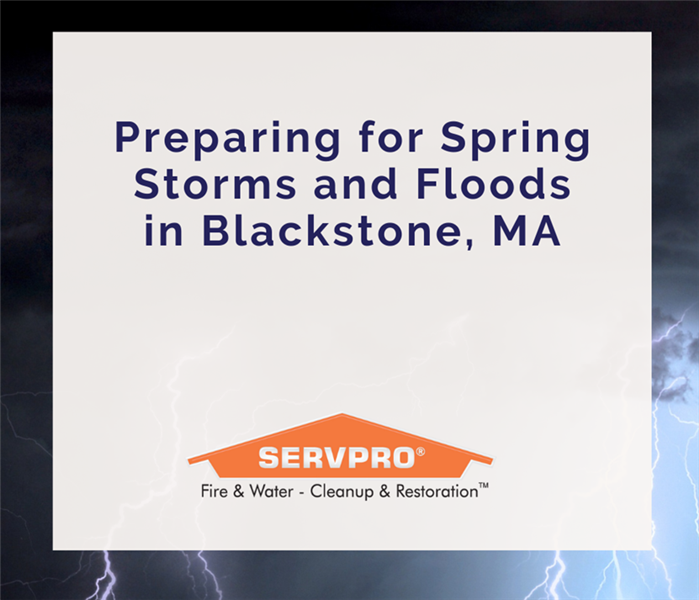 Preparedness is key to minimizing the impact of severe weather on your property and business.
Preparedness is key to minimizing the impact of severe weather on your property and business.
Spring brings renewal but also weather challenges, such as heavy rainfall, high winds, and flooding, which can threaten commercial properties in Blackstone, MA. Here are tips for preparing your property:
- Inspect Your Roof: Check for damage or wear and tear. Repair or replace damaged shingles or flashing to prevent leaks during heavy rain.
- Clean Gutters and Downspouts: Ensure proper drainage by cleaning them. Clogged gutters can lead to water damage to the building's exterior and foundation.
- Check Drainage Systems: Clear debris from storm drains and culverts to prevent flooding during heavy rain.
- Trim Trees and Shrubs: Prevent damage from high winds by trimming them, also reducing the risk of roof and window damage.
- Inspect Windows and Doors: Seal gaps or cracks with weatherstripping or caulk to prevent water seepage during storms.
- Secure Outdoor Items: Prevent damage by securing outdoor furniture, signage, and other items that could become projectiles in strong winds.
- Backup Important Data: Protect data and documents from loss by backing them up in a secure off-site location or in the cloud.
- Create an Emergency Plan: Develop a plan outlining what to do in severe storms or floods, including evacuation routes, emergency contacts, and utility shut-off procedures.
- Review Insurance Coverage: Ensure adequate protection against storm and flood damage, considering adding flood insurance for flood-prone areas.
- Stay Informed: Monitor weather forecasts and alerts to stay ahead of potential storms or flooding.
Taking these proactive measures can protect your commercial property from spring storms and floods. Preparedness is key to minimizing the impact of severe weather on your property and business. SERVPRO Of Natick Milford is available to assist with your commercial or residential property needs.
We are proud to serve our local communities:
Natick, MA, Milford, MA, Mendon, MA, Blackstone, MA, Holliston, MA, North Natick, MA, South Natick, MA, Hopedale, MA
Preventing Water Damage in Commercial Buildings Tips for Property Managers in Milford, MA
5/20/2024 (Permalink)
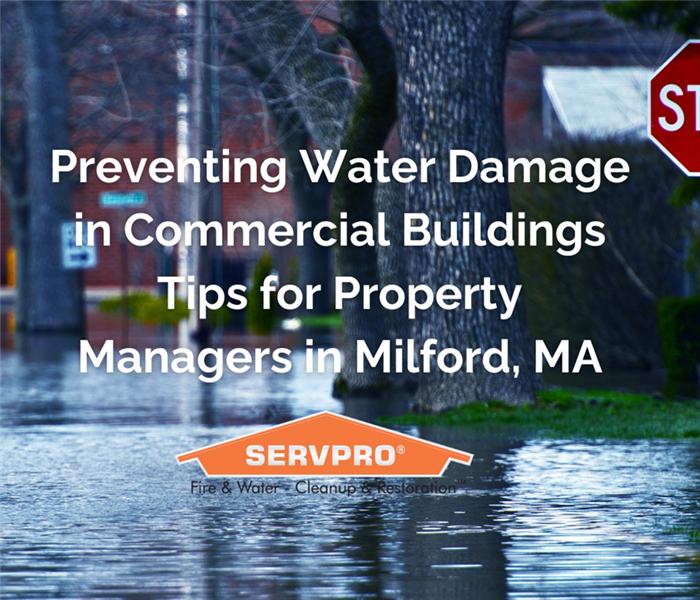 Following these measures can mitigate water damage risks and safeguard your property investment.
Following these measures can mitigate water damage risks and safeguard your property investment.
As a property manager in Milford, MA, it's crucial to address this issue proactively and safeguard your building.
- Regular inspections are vital. Thoroughly examine your building's plumbing, roof, and foundation for any signs of leaks, such as water stains, mold, or moisture. Ensure your roof and gutters are well-maintained to prevent water accumulation, keeping them free from leaks and debris. Regularly cleaning gutters and downspouts is essential.
- Monitoring water pressure helps prevent strain on your plumbing system. Consider installing a pressure regulator to maintain optimal levels. Additionally, inspect and maintain sprinkler systems if your building is equipped with one, ensuring they are operational and unobstructed.
- Check household appliances like water heaters, dishwashers, and refrigerators for any leaks or damages, replacing worn components as needed. Properly seal windows and doors to prevent water infiltration during inclement weather.
- Installing water detection devices in areas prone to leaks, such as basements, mechanical rooms, and bathrooms, can provide early warnings. Educating tenants on promptly reporting any leaks and establishing a water damage response plan are essential steps.
- Establishing a routine maintenance schedule for plumbing, HVAC systems, and roofs is crucial. Addressing issues promptly prevents them from escalating into larger problems.
Following these measures can mitigate water damage risks and safeguard your property investment. If assistance is required in Milford, MA, SERVPRO Of Natick Milford is ready to provide water damage restoration services.
We are proud to serve our local communities:
Natick, MA, Milford, MA, Mendon, MA, Blackstone, MA, Holliston, MA, North Natick, MA, South Natick, MA, Hopedale, MA
Water Damage Assessment and Restoration Process in Holliston, MA
4/17/2024 (Permalink)
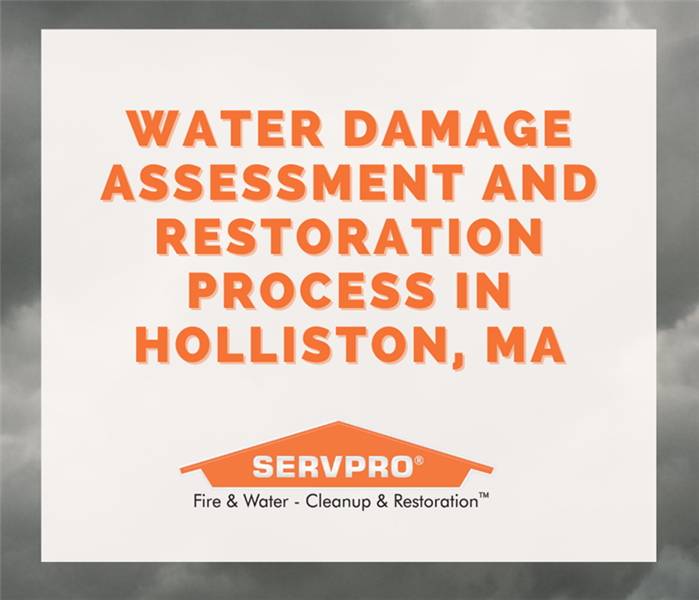 Prolonged moisture can lead to mold growth, compromised structural integrity, and health risks.
Prolonged moisture can lead to mold growth, compromised structural integrity, and health risks.
Water damage can swiftly cause chaos in your home or business, leading to structural damage, mold growth, and health hazards.
Understanding the proper assessment and restoration process is crucial for effectively mitigating destruction and restoring your property to its preloss condition. Let's break down the key steps involved in this critical process.
Step 1: Inspection and Assessment
Trained professionals conduct a thorough inspection and assessment of the affected areas, using specialized tools like moisture meters and thermal imaging cameras. They identify the water source, assess the damage extent, and determine the most effective restoration plan, even detecting hidden moisture pockets.
Step 2: Water Extraction
All standing water is removed from the premises using industrial-grade pumps, wet/dry vacuums, and specialized extraction equipment. Prompt water removal prevents further spread and secondary damage.
Step 3: Drying and Dehumidification
High-speed air movers and dehumidifiers are strategically placed to dry out the affected area and restore normal humidity levels. This process may take several days, depending on the impacted materials and saturation levels.
Step 4: Restoration and Repair
After complete drying, the restoration and repair phase begins. Damaged drywall, flooring, structures, and contents are repaired or replaced to return the property to its preloss condition, clean, safe, and habitable.
The Importance of Swift Response
Acting quickly is crucial when water damage occurs. Prolonged moisture can lead to mold growth, compromised structural integrity, and health risks. By responding immediately and involving trained professionals, you minimize destruction extent and expedite the restoration process, ensuring your property is restored efficiently.
Service Areas
Natick, MA, Milford, MA, Mendon, MA, Blackstone, MA, Holliston, MA, North Natick, MA, South Natick, MA, Hopedale, MA
Handling a Flood in Your House, Steps to Take for a Swift Recovery
3/27/2024 (Permalink)
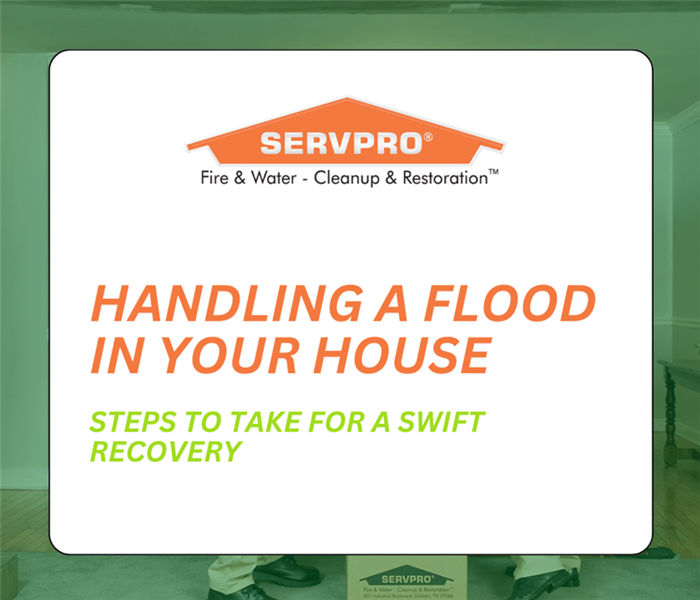 SERVPRO Of Natick Milford is The #1 Choice in Cleanup and Restoration for residential buildings’ fire, mold, water, and storm damage.
SERVPRO Of Natick Milford is The #1 Choice in Cleanup and Restoration for residential buildings’ fire, mold, water, and storm damage.
Experiencing a flood in your home in Wellesley, MA can be a devastating and overwhelming event. Whether caused by heavy rain, a burst pipe, or a malfunctioning appliance, flooding can wreak havoc on your property and belongings. Knowing what to do in the aftermath of a flood can help you minimize damage and start the recovery process. Here's a guide on handling a flood in your Wellesley, MA home:
Ensure Safety: Your safety is paramount. If floodwaters are rising and pose a risk, evacuate immediately. Avoid walking or wading through floodwater, as it may be contaminated or hiding hazards.
Turn Off Utilities: If it's safe to do so, turn off electricity, gas, and water to prevent further damage and reduce electrical hazards.
Document the Damage: Take photos or videos of the floodwater and damage for insurance claims and restoration purposes.
Remove Water: Use pumps, wet/dry vacuums, or buckets to remove standing water. Lingering water can lead to mold growth and further damage.
Dry Out the Area: Utilize fans, dehumidifiers, and open windows to dry the area. Mold can grow quickly, so begin drying as soon as possible.
Remove Damaged Items: Dispose of unsalvageable items such as furniture, carpets, and saturated drywall. Document these items for insurance purposes before disposal.
Clean and Disinfect: Thoroughly clean and disinfect surfaces that came into contact with floodwater. Use a bleach solution to kill bacteria and mold spores.
Contact Your Insurance Company: Notify your insurance company of the flood damage and follow their instructions for filing a claim.
Hire a Professional Restoration Company: Consider hiring professionals for cleanup and restoration. They have the expertise and equipment for effective restoration.
Prevent Future Floods: After cleanup, take steps to prevent future floods, such as installing a sump pump or ensuring proper drainage.
By following these steps, you can effectively manage the aftermath of a flood and protect your property and belongings.
SERVPRO Of Natick Milford is The #1 Choice in Cleanup and Restoration for residential buildings’ fire, mold, water, and storm damage. We are ready to assist businesses in Natick, MA | Milford, MA | Blackstone, MA | Mendon, MA | Holliston, MA | South Natick, MA | North Natick, MA | Hopedale, MA
Drowning in Damage in Natick Milford? Trust Our Water Restoration Experts to Save the Day
2/8/2024 (Permalink)
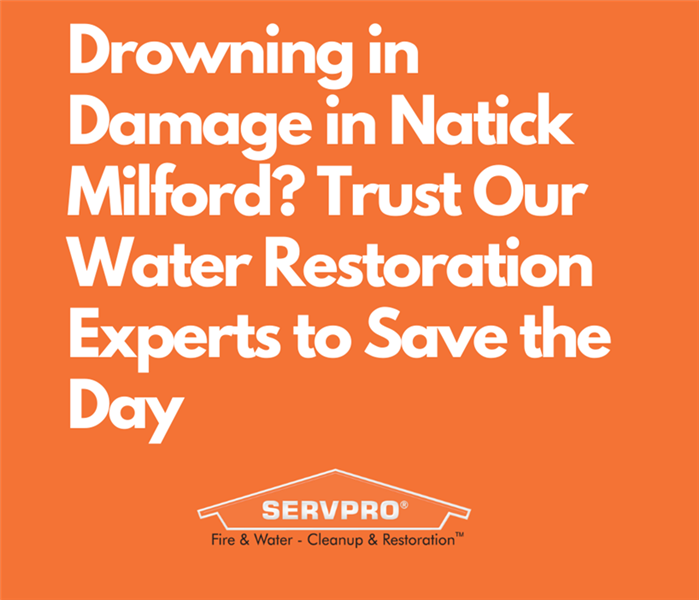 Trusting professionals to handle the restoration process ensures a thorough and effective response.
Trusting professionals to handle the restoration process ensures a thorough and effective response.
Water damage can strike unexpectedly, wreaking havoc on homes and businesses alike. Whether it's a burst pipe, flooding, or a leaky roof, the aftermath of water damage can be overwhelming. In times like these, it's crucial to have a reliable team of water restoration experts to help salvage your property and restore it to its former glory. Let’s explore the importance of professional water restoration services and why you should trust experts to save the day.
- Swift Response to Mitigate Further Damage: When water damage occurs, time is of the essence. The longer the water sits, the more extensive the damage becomes. Professional water restoration experts understand the urgency and respond swiftly to mitigate further damage. Their prompt actions can prevent mold growth, structural issues, and other long-term consequences.
- Thorough Assessment and Planning: Water damage restoration is not a one-size-fits-all process. Each case is unique, requiring a thorough assessment of the extent of the damage. Experts carefully examine affected areas, identify potential hazards, and create a customized restoration plan. This ensures that every aspect of the damage is addressed effectively.
- State-of-the-Art Equipment and Techniques: Professional water restoration teams are equipped with state-of-the-art tools and techniques to handle water damage efficiently. Industrial-strength water extractors, dehumidifiers, and drying equipment are employed to remove excess water and moisture. This advanced equipment accelerates the drying process and minimizes the risk of secondary damage.
- Mold Remediation: One of the significant risks associated with water damage is the growth of mold. Mold can start to develop within 24-48 hours in damp environments. Water restoration experts have the knowledge and experience to identify and eliminate mold, ensuring a safe and healthy living or working environment.
- Insurance Liaison and Documentation: Dealing with insurance companies can be a complex and time-consuming process. Water restoration professionals often have experience working with insurance providers. They can assist in documenting the damage, providing accurate assessments, and facilitating a smoother claims process.
- Comprehensive Restoration Services: Beyond water extraction and drying, professional restoration services encompass a wide range of tasks. This may include repairing structural damage, restoring damaged belongings, and ensuring the overall safety and functionality of the property. A comprehensive approach ensures that no aspect of the restoration process is overlooked.
- Peace of Mind for Homeowners and Business Owners: Facing water damage can be emotionally and mentally draining. Hiring water restoration experts provides peace of mind, knowing that trained professionals are handling the situation. This allows homeowners and business owners to focus on rebuilding and moving forward.
Water damage is a formidable adversary, but with the right team of water restoration experts by your side, recovery is not only possible but efficient. Trusting professionals to handle the restoration process ensures a thorough and effective response, giving you the best chance to salvage your property and move beyond the damage. When drowning in damage, don't hesitate to call on the expertise of water restoration professionals to save the day in Natick Milford.
SERVPRO Of Natick Milford is The #1 Choice in Cleanup and Restoration for residential and commercial buildings’ fire, mold, water, and storm damage.
Commercial Water Damage Restoration Specialists in Natick Milford, MA.
12/8/2023 (Permalink)
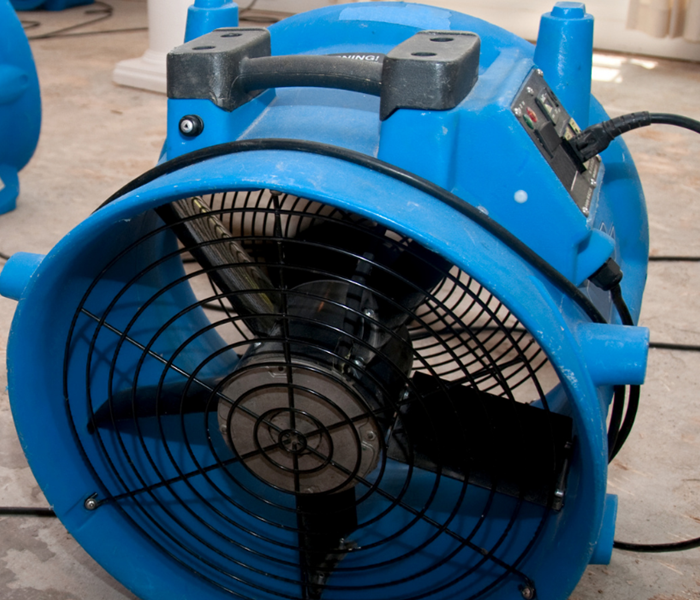 Commercial water damage restoration specialists navigate the aftermath of water-related disasters,.
Commercial water damage restoration specialists navigate the aftermath of water-related disasters,.
Water damage poses a subtle yet formidable threat to commercial properties, resulting not only in physical harm but also in financial and operational setbacks.
In times of crisis, commercial water damage restoration specialists emerge as unsung heroes, working tirelessly behind the scenes to restore normalcy. Let's delve into the crucial role these specialists play and why their expertise is vital in addressing water-related emergencies in Natick Milford, MA.
- The Silent Threat: Water damage is an omnipresent issue stemming from various sources, such as burst pipes, flooding, leaks, or natural disasters. Commercial properties are particularly susceptible, given that the repercussions extend beyond visible destruction. Mold growth, structural compromise, and damage to valuable assets can lead to substantial financial losses if not promptly and effectively addressed.
The Role of Commercial Water Damage Restoration Specialists:
- Swift Response and Assessment: Recognizing the urgency in mitigating water-related disasters, specialists act promptly to assess the extent of the damage and devise an effective restoration plan. Timely action prevents secondary damage and reduces the overall impact on the property.
- Advanced Equipment and Techniques: Armed with cutting-edge tools and technology, specialists efficiently extract water, dehumidify affected areas, and restore the property to its pre-damage condition. Leveraging powerful water pumps and industrial-grade dehumidifiers, they expedite the restoration process.
- Meticulous Restoration Planning: Understanding the uniqueness of each water damage scenario, specialists meticulously assess the situation, identifying the best course of action. This planning considers structural integrity, potential mold growth, and salvaging valuable assets.
- Expertise in Mold Remediation: Following water damage, the risk of mold growth is a significant concern. Specialists are well-versed in mold remediation techniques, ensuring thorough cleaning and treatment of affected areas to prevent future infestations and maintain a safe working environment.
- Coordination with Stakeholders: Effective communication and coordination with property owners, insurance providers, and other stakeholders are integral to the restoration process. Specialists act as liaisons, providing transparent updates and ensuring all involved parties are informed about progress and next steps.
Commercial water damage restoration specialists navigate the aftermath of water-related disasters, playing a pivotal role in minimizing the impact on businesses and communities. Their expertise, coupled with advanced equipment and a commitment to swift, efficient restoration, underscores their significance. By recognizing and appreciating the indispensable work of these specialists, we gain a deeper understanding of the value they bring and the crucial role they play in safeguarding commercial properties from the silent threat of water damage in Natick Milford, MA.
SERVPRO Of Natick Milford is The #1 Choice in Cleanup and Restoration of commercial buildings’ fire damage.
How Does Water Damage Start in Natick Milford?
10/27/2023 (Permalink)
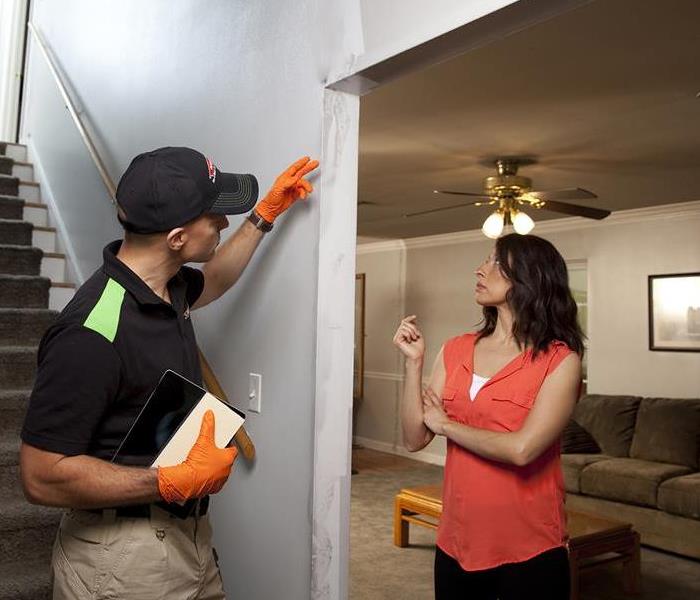 How Does Water Damage Start in Natick Milford? Water doesn't stand a chance against SERVPRO Of Natick Milford
How Does Water Damage Start in Natick Milford? Water doesn't stand a chance against SERVPRO Of Natick Milford
Understanding the initiation of water damage is pivotal for its prevention and timely intervention. Various factors contribute to the onset of water damage, each with a cascading impact on our homes:
- Roof Leaks and Shingle Damage: A compromised roof, often due to damaged or missing shingles, stands as a primary instigator of water damage. Roof leaks permit water infiltration into the attic and other structural components, resulting in wood decay, weakened ceilings, and eventual water stains on interior walls.
- Plumbing Malfunctions: Water damage frequently commences with leaky pipes, burst hoses, and faulty plumbing fixtures. Unnoticed leaks can rapidly escalate, causing damage to walls, flooring, and even the foundational structure of the house. Regular inspections and swift repairs are imperative to mitigate risks associated with plumbing-related water damage.
- Clogged Gutters and Downspouts: The vital role of gutters and downspouts in redirecting rainwater becomes compromised when clogged with debris. Overflowing water saturates exterior walls, leading to structural damage, mold growth, and erosion around the foundation.
- Inadequate Window and Door Seals: Poorly sealed windows and doors become vulnerable points for water entry, especially during heavy rain or storms. Persistent water infiltration can result in frame decay, damaged drywall, and compromised structural integrity. Regular inspections and resealing of these entry points are essential for preventing water damage.
- Basement Flooding: Basements, positioned below ground level, face susceptibility to water damage due to factors like heavy rainfall, poor drainage, or a high water table. Flooding can cause extensive harm to walls, flooring, and belongings stored in the basement.
- Appliance Leak Risks: Common household appliances, such as washing machines, dishwashers, and water heaters, pose a risk of water damage if they develop leaks. Malfunctioning appliances or worn-out hoses can release water, leading to damage to floors, walls, and nearby possessions.
Recognizing that water damage can originate in diverse ways empowers homeowners to identify signs and promptly address root causes. Regular maintenance, timely repairs, and a proactive approach to potential water entry points serve as crucial safeguards against the pervasive threat of water damage, ensuring a dry and secure living environment for years to come.
Water doesn't stand a chance against SERVPRO Of Natick Milford commercial and residential remediation services. We're not just another remediation company; we're your partners in ensuring a safe, healthy environment. So, if you're facing a water problem, don't hesitate. You can reach a member of our team 24/7/365.
Preventing Ice Dams: A Guide to Protecting Your Home in Natick Milford.
10/18/2023 (Permalink)
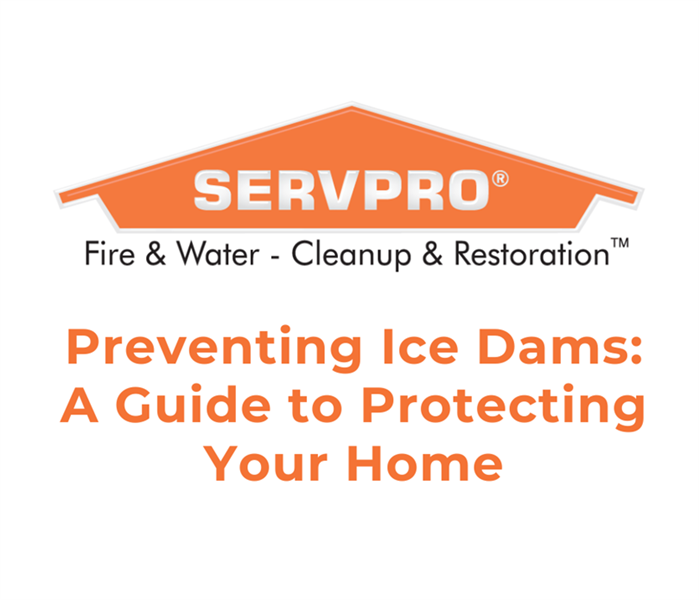 Embrace the winter season warmly, dryly, and to the fullest!
Embrace the winter season warmly, dryly, and to the fullest!
Winter possesses the potential for enchantment, yet it also introduces a set of challenges, particularly for homeowners in Natick Milford, MA.
Among the prevalent and potentially detrimental issues in the winter months is the emergence of ice dams on rooftops. Safeguarding your home involves understanding what ice dams are, why they form, and, crucially, how to prevent them.
Comprehending Ice Dams
Ice dams manifest as ridge-like accumulations of ice along the roof's edge, impeding the drainage of melting snow and ice. This can lead to water backup and potential infiltration into your home. The process typically unfolds as follows:
- Snow Accumulation: Your roof becomes blanketed in a layer of snow.
- Heat Loss: The heat from your home escapes through the roof, causing snow on the upper section to melt.
- Freezing Point: As the melted water reaches the colder lower section of the roof, it refreezes, forming an ice dam.
- Water Backup: Ongoing snowmelt flows towards the ice dam, creating a pool of water that may find its way into your home through roof or siding gaps.
Significance of Preventing Ice Dams
Ice dams can wreak havoc on your home in multiple ways:
- Roof Damage: The weight of ice dams can harm the roof's structure and shingles, necessitating costly repairs.
- Water Damage: Trapped water on the roof can infiltrate your home, causing extensive damage to ceilings, walls, and insulation.
- Mold and Mildew: Moisture infiltration fosters mold and mildew growth, posing health risks.
- Energy Loss: Ice dams often form due to escaping heat, resulting in energy loss and increased heating bills.
Understanding the risks, here are practical steps to prevent ice dams:
- Proper Insulation: Ensure adequate attic insulation to maintain a uniform roof temperature.
- Ventilation: Install roof and soffit vents for consistent attic air circulation.
- Seal Gaps: Seal openings in the roof, walls, and attic to minimize warm air leakage.
- Attic Air Sealing: Prevent warm air from escaping into the attic space.
- Roof Raking: After heavy snowfall, use a roof rake to remove excess snow, reducing the potential for melting.
- Ice Dam Membranes: Consider installing an ice and water shield membrane to prevent water infiltration.
- Gutter Maintenance: Keep gutters clean and install heated cables to prevent ice buildup.
- Professional Inspection: Schedule regular roofing inspections to address issues before they escalate.
Proactively insulating your home, enhancing ventilation, and conducting regular maintenance significantly diminish the risk of ice dams. This not only preserves your home's integrity but also controls energy costs, ensuring a warm and dry winter in Blackstone, MA. Prevention now can save considerable trouble and expense in the future. Embrace the winter season warmly, dryly, and to the fullest!
SERVPRO® Of Natick Milford is The #1 Choice in Cleanup and Restoration for residential and commercial buildings’ fire, mold, water, and storm damage. Call us today at (774) 290-4300.
Dealing with Water Damage: A Comprehensive Guide
9/27/2023 (Permalink)
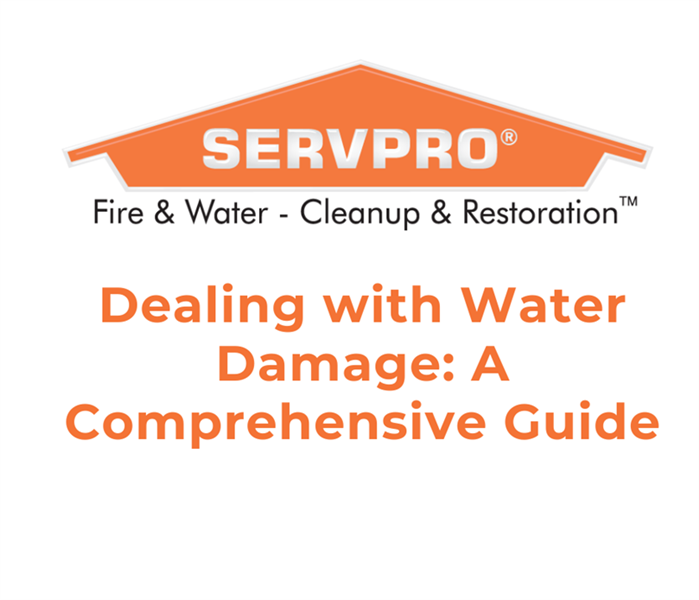 After the cleanup and restoration are complete, take steps to prevent future water damage.
After the cleanup and restoration are complete, take steps to prevent future water damage.
Water damage can be a homeowner's worst nightmare. Whether it's from a burst pipe, a leaky roof, a flood, or any other source, the aftermath of water damage can be overwhelming. Here are the essential steps to take when faced with water damage.
Ensure Safety First: Turn off the power to the affected area to avoid electrical hazards. If necessary, wear protective gear such as rubber gloves and waterproof boots to prevent contact with contaminated water.
Identify the Source and Stop It: Determine the source of the water and take immediate steps to stop it. If it's a burst pipe, turn off the water supply to that area or the entire house. For roof leaks, place buckets or tarps to divert water away from the damaged area temporarily.
Document the Damage: Take photographs or videos of the water damage before you begin cleanup or contact your insurance company. Proper documentation can help support your insurance claim.
Call Your Insurance Company: Contact your homeowner's insurance provider as soon as possible to report the water damage. Provide them with all the necessary information, including photos and videos, so they can initiate the claims process. Be sure to ask about the specific coverage and deductible for water damage in your policy.
Remove Water and Moisture: The longer water sits, the more damage it can cause. Begin the drying process immediately by removing excess water using pumps, wet/dry vacuums, or towels. Open windows and doors to encourage ventilation and help speed up the drying process.
Salvage Valuables: Remove valuable and sentimental items from the affected area to prevent further damage. Furniture, electronics, and personal belongings should be relocated to a dry and safe place. If items are already waterlogged, consult with professionals on restoration possibilities.
Prevent Mold Growth: Mold can start growing within 24 to 48 hours after water damage occurs. To prevent mold growth, thoroughly dry and disinfect the affected area. Use fans and dehumidifiers to reduce humidity levels, and consider using mold-resistant products during repairs.
Assess Structural Damage: Check for any structural damage that may have occurred due to the water. This includes inspecting walls, ceilings, floors, and the foundation. If you suspect structural issues, consult with a professional contractor or engineer.
Repair and Restore: Once the affected area is completely dry, you can start the repair and restoration process. Depending on the extent of the damage, you may need to replace drywall, insulation, flooring, or other structural components. Work with reputable contractors or restoration specialists to ensure quality repairs.
Prevent Future Water Damage: After the cleanup and restoration are complete, take steps to prevent future water damage. Regularly inspect your home for leaks, maintain your plumbing system, and consider installing a sump pump or backflow preventer if you're in a flood-prone area.
Dealing with water damage can be stressful, but by following these steps and acting quickly, you can minimize the damage and ensure a smoother recovery process. Remember that safety should always be your top priority, and seeking professional help when needed can make a significant difference in the outcome. With proper precautions and a well-executed plan, you can restore your home to its former glory and safeguard it against future water damage.
SERVPRO Of Natick Milford is The #1 Choice in Cleanup and Restoration for residential and commercial buildings’ fire, mold, water, and storm damage. If you are looking for assistance, just click on the contact us page, and someone will be in touch shortly.
Protect Your Home Against a Flood in Natick Milford, MA: Essential Tips to Safeguard Your Abode
8/16/2023 (Permalink)
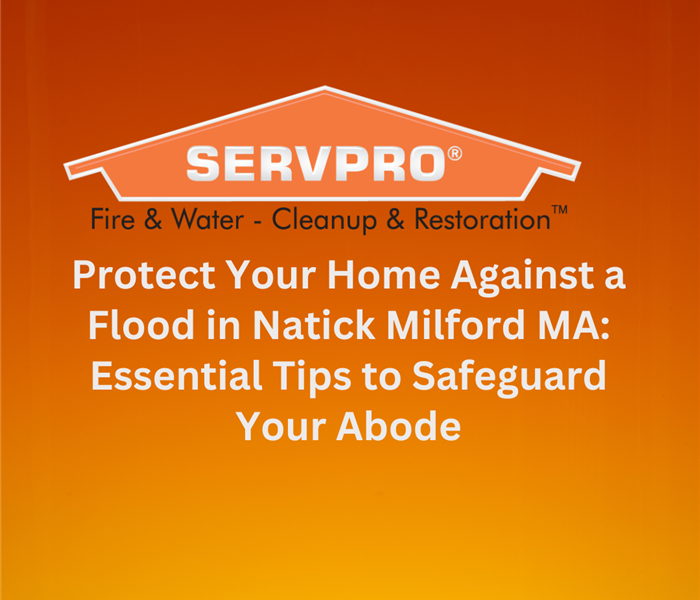 Floods are among the most destructive and devastating natural disasters.
Floods are among the most destructive and devastating natural disasters.
Floods are among the most destructive and devastating natural disasters. Here are some essential tips and strategies to safeguard your home and loved ones from the destructive force of floods.
- Understand the Flood Risk in Your Area: The first step in flood protection is to understand the flood risk in your area. Check local flood maps and seek information from relevant authorities about historical flood events in your region.
- Elevate Electrical Systems: Electrical systems are highly vulnerable during floods and can pose a significant safety hazard. Hire a professional electrician to elevate all electrical outlets, switches, sockets, and wiring above the expected flood levels.
- Waterproof Your Basement: Basements are highly susceptible to flooding due to their location below ground level. Seal any cracks in the foundation and walls to prevent water seepage. Consider installing a sump pump to remove any accumulated water.
- Elevate Appliances and Furnishings: Raise your valuable appliances, including washers, dryers, water heaters, and furnaces, on elevated platforms to keep them above potential floodwaters.
- Install Flood Barriers and Sandbags: Temporary flood barriers and sandbags can act as a first line of defense during a flood event. Stock up on sandbags and know how to properly stack and place them around vulnerable areas, such as doors and windows, to create a barrier against incoming water.
- Secure Sewage Backflow Valves: During severe floods, there's a risk of sewage backflow, which can lead to contamination and further damage. Installing sewage backflow valves in your home's plumbing system can help prevent sewage from entering your property.
- Create Adequate Drainage: Ensure that your property has proper drainage systems in place to direct water away from your home's foundation. Clean gutters, downspouts, and drains regularly to prevent blockages that may lead to water pooling around your home.
- Elevate Outdoor Utilities: Just like indoor electrical systems, outdoor utilities such as air conditioning units and fuel tanks should be raised above potential flood levels to minimize damage and reduce safety risks.
- Purchase Flood Insurance: Standard homeowner's insurance policies usually do not cover flood damage. It's essential to invest in separate flood insurance coverage to protect your home and belongings in case of a flood event.
While we cannot control natural disasters like floods, we can take proactive steps to protect our homes and loved ones from their devastating effects. By understanding the flood risk in our area and implementing the above-mentioned flood protection measures, we can significantly reduce the potential impact of floods on our homes.
When it comes to cleanup and restoration services for fire, mold, water, and storm damage in residential and commercial buildings, SERVPRO of Natick Milford proudly holds the top position as the number one choice. Our comprehensive services cover a wide range of areas, including Blackstone, Hopedale, Mendon, Milford, Natick, North Natick, and South Natick, MA. Rest assured, we are here to provide unmatched expertise and efficiency to restore your property to its former glory.
Protect Your Home Against a Flood in Natick Milford, MA: Essential Tips to Safeguard Your Abode
8/16/2023 (Permalink)
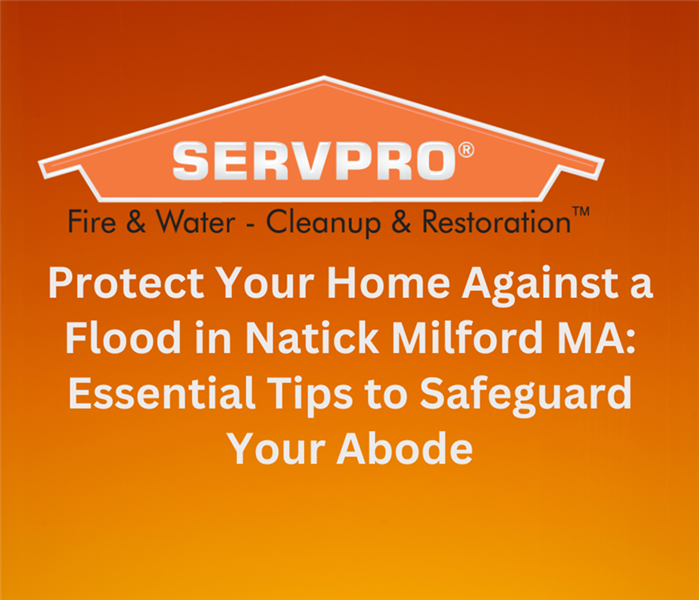 Floods are among the most destructive and devastating natural disasters.
Floods are among the most destructive and devastating natural disasters.
Floods are among the most destructive and devastating natural disasters. Here are some essential tips and strategies to safeguard your home and loved ones from the destructive force of floods.
- Understand the Flood Risk in Your Area: The first step in flood protection is to understand the flood risk in your area. Check local flood maps and seek information from relevant authorities about historical flood events in your region.
- Elevate Electrical Systems: Electrical systems are highly vulnerable during floods and can pose a significant safety hazard. Hire a professional electrician to elevate all electrical outlets, switches, sockets, and wiring above the expected flood levels.
- Waterproof Your Basement: Basements are highly susceptible to flooding due to their location below ground level. Seal any cracks in the foundation and walls to prevent water seepage. Consider installing a sump pump to remove any accumulated water.
- Elevate Appliances and Furnishings: Raise your valuable appliances, including washers, dryers, water heaters, and furnaces, on elevated platforms to keep them above potential floodwaters.
- Install Flood Barriers and Sandbags: Temporary flood barriers and sandbags can act as a first line of defense during a flood event. Stock up on sandbags and know how to properly stack and place them around vulnerable areas, such as doors and windows, to create a barrier against incoming water.
- Secure Sewage Backflow Valves: During severe floods, there's a risk of sewage backflow, which can lead to contamination and further damage. Installing sewage backflow valves in your home's plumbing system can help prevent sewage from entering your property.
- Create Adequate Drainage: Ensure that your property has proper drainage systems in place to direct water away from your home's foundation. Clean gutters, downspouts, and drains regularly to prevent blockages that may lead to water pooling around your home.
- Elevate Outdoor Utilities: Just like indoor electrical systems, outdoor utilities such as air conditioning units and fuel tanks should be raised above potential flood levels to minimize damage and reduce safety risks.
- Purchase Flood Insurance: Standard homeowner's insurance policies usually do not cover flood damage. It's essential to invest in separate flood insurance coverage to protect your home and belongings in case of a flood event.
While we cannot control natural disasters like floods, we can take proactive steps to protect our homes and loved ones from their devastating effects. By understanding the flood risk in our area and implementing the above-mentioned flood protection measures, we can significantly reduce the potential impact of floods on our homes.
When it comes to cleanup and restoration services for fire, mold, water, and storm damage in residential and commercial buildings, SERVPRO of Natick Milford proudly holds the top position as the number one choice. Our comprehensive services cover a wide range of areas, including Blackstone, Hopedale, Mendon, Milford, Natick, North Natick, and South Natick, MA. Rest assured, we are here to provide unmatched expertise and efficiency to restore your property to its former glory.
Restoring Brilliance: A Comprehensive Guide to Rebuilding After Water Damage
7/7/2023 (Permalink)
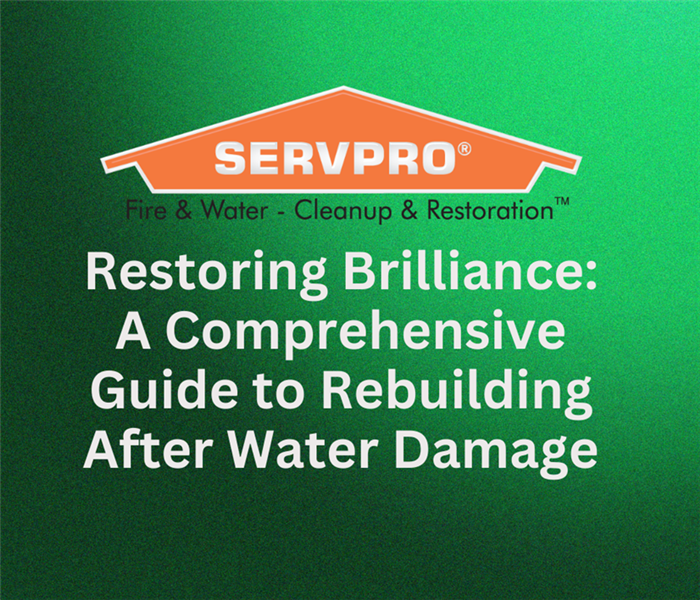 Rebuilding a water-damaged building requires meticulous planning, careful execution, and collaboration.
Rebuilding a water-damaged building requires meticulous planning, careful execution, and collaboration.
Water damage can have devastating effects on the structural integrity, functionality, and appearance of any building. Whether it's caused by floods, burst pipes, or leaks, responding promptly and planning carefully are essential for successful restoration. This comprehensive guide will take you through the step-by-step process of rebuilding a water-damaged building, ensuring a safe, efficient, and visually appealing transformation.
Step 1: Evaluate the Extent of Damage: Before initiating the rebuilding process, it's crucial to conduct a thorough assessment of the water damage. Enlist the services of a professional inspector or a reputable restoration company to determine the magnitude of structural, electrical, and mold-related issues. This evaluation will provide valuable insights necessary for effective restoration planning.
Step 2: Prioritize Safety: Safety should always be the top priority when working on a water-damaged building. Prior to entering the premises, ensure that the electrical power is shut off to prevent potential hazards. Take necessary precautions to avoid slips, falls, and exposure to contaminated water. Utilize appropriate personal protective equipment (PPE), including gloves, masks, and boots.
Step 3: Water Extraction and Drying: The removal of water is a critical step in the restoration process. Utilize industrial-grade pumps, wet vacuums, and dehumidifiers to extract standing water from the affected areas. Promote proper air circulation by opening windows, using fans, and employing specialized drying equipment. Eliminating excess moisture is imperative to prevent mold growth and further damage to the structure.
Step 4: Mold Remediation: Moisture-laden environments provide optimal conditions for mold growth. If mold is detected, consult professionals experienced in mold remediation. They will assess the extent of mold contamination, perform thorough cleaning, and ensure proper ventilation to prevent future mold outbreaks. Taking prompt action will safeguard the health of occupants and maintain the building's integrity.
Step 5: Structural Repairs: Once the affected areas are dry and mold-free, it's time to address structural damage. Engage qualified contractors or construction professionals to repair weakened walls, floors, ceilings, and foundations. Reinforce compromised structures, replace damaged materials, and ensure compliance with building codes and regulations. Conduct necessary plumbing repairs and inspections to prevent future water-related issues.
Step 6: Electrical and HVAC Systems: Water damage can significantly impact electrical and HVAC (heating, ventilation, and air conditioning) systems, posing potential safety hazards. Enlist licensed electricians and HVAC technicians to thoroughly inspect, repair, or replace damaged components. Ensure that all systems meet safety standards and regulations before reconnecting utilities.
Step 7: Interior Restoration: The rebuilding process also involves restoring the interior spaces to their former glory. Evaluate and replace damaged insulation, drywall, flooring, and fixtures. Repaint walls, applying mold-resistant coatings where necessary. Consider using waterproof materials for added protection. Consult interior designers or decorators to envision and create functional, aesthetically pleasing spaces.
Step 8: Prevention and Preparedness: To mitigate the risk of future water damage, implement preventive measures. Install water detection systems, reinforce waterproofing measures, and regularly inspect plumbing and roof systems. Educate occupants on proactive steps to prevent water-related accidents and encourage immediate reporting of leaks or other issues.
Rebuilding a water-damaged building requires meticulous planning, careful execution, and collaboration among various professionals. By following this comprehensive guide, you can navigate the restoration process with confidence, ensuring the safety, functionality, and beauty of the rebuilt structure.
SERVPRO Of Natick Milford, the leading choice for cleanup and restoration services in residential and commercial buildings, specializes in fire, mold, water, and storm damage. We proudly serve Blackstone, Hopedale, Mendon, Milford, Natick, North Natick, and South Natick, MA.
How to prepare for a rainstorm
4/26/2023 (Permalink)
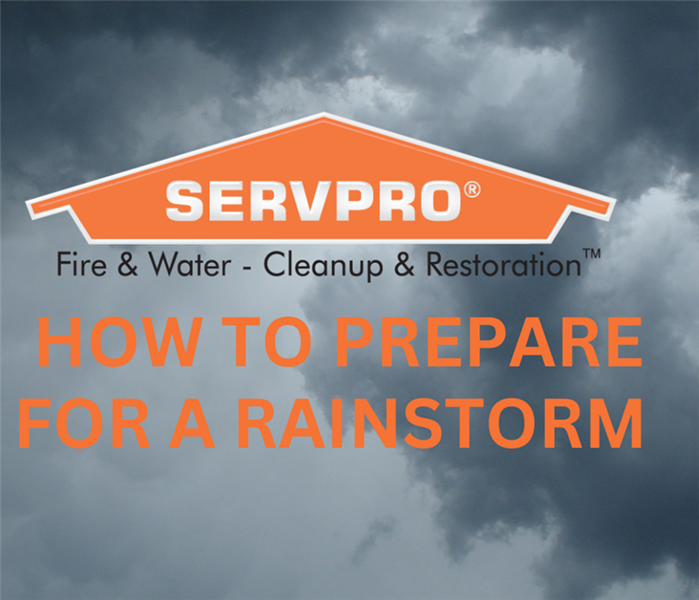 Preparing for a rainstorm is essential for minimizing damage and staying safe.
Preparing for a rainstorm is essential for minimizing damage and staying safe.
Rainstorms can come on suddenly and unexpectedly. Learn how to prepare for a rainstorm and what steps you can take to minimize damage and stay safe.
- Check the weather forecast: Before you head out, make sure to check the weather forecast. This will help you determine if a rainstorm is likely and when it is expected to arrive. You can plan your activities accordingly and be prepared for any changes in the weather.
- Make a plan: If you live in an area prone to heavy rain, it's important to have a plan in case of a rainstorm. This includes knowing where to go if you need to evacuate and having an emergency kit with essentials such as food, water, and a first aid kit.
- Protect your home: To protect your home from rain damage, make sure that your gutters are clear of debris and that your roof is in good condition. This will prevent water from seeping into your home and causing damage. You may also want to invest in sandbags to prevent flooding in low-lying areas.
- Pack accordingly: If you're planning a trip during the rainy season, make sure to pack accordingly. Bring rain gear such as a waterproof jacket and boots, as well as an umbrella. You may also want to pack a change of clothes and waterproof bags to keep your belongings dry.
- Secure loose items: Before a rainstorm arrives, make sure to secure any loose items outside, such as patio furniture or outdoor toys. This will prevent them from being blown away by the wind or causing damage during the storm.
- Stay indoors: During a rainstorm, it's best to stay indoors if possible. Avoid driving unless it is necessary, as rain can make roads slippery and reduce visibility. If you do need to go outside, make sure to wear appropriate rain gear and stay away from downed power lines or standing water.
- Stay informed: Finally, stay informed during a rainstorm. Listen to local news and weather reports for updates and alerts. Be aware of any potential dangers, such as flooding or landslides, and take appropriate action to stay safe.
Preparing for a rainstorm is essential for minimizing damage and staying safe.
We service Blackstone, Hopedale, Mendon, Milford, Natick, North Natick, and South Natick MA.
SERVPRO Of Natick Milford is The #1 Choice in Cleanup and Restoration for residential and commercial buildings’ fire, mold, water, and storm damage.
What happens if I don’t fix the water damage?
4/20/2023 (Permalink)
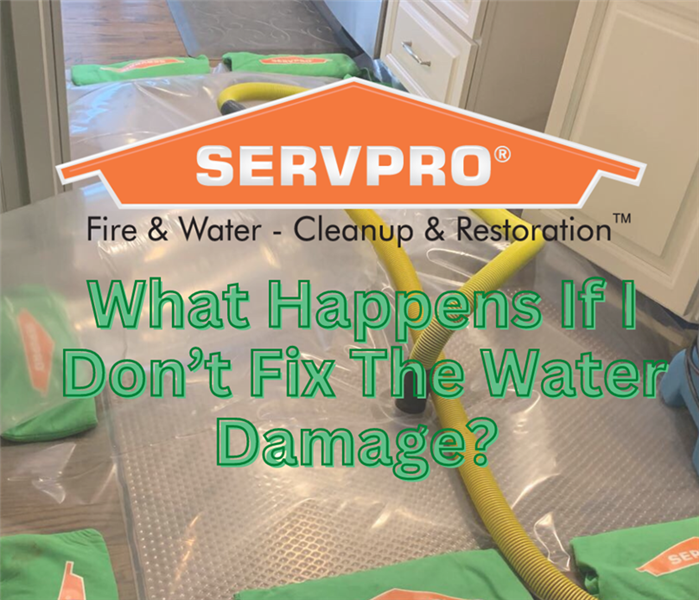 It is important to seek professional help to repair and restore your home to its pre-damaged condition.
It is important to seek professional help to repair and restore your home to its pre-damaged condition.
Water damage can be caused by a variety of factors such as leaky pipes, flooding, or a damaged roof.
- Structural damage: Water can weaken the structural integrity of your home, causing warping, cracking, and even collapse of your floors, walls, and ceilings.
- Mold growth: Water damage creates a perfect environment for mold to grow, which can lead to serious health problems such as respiratory issues and allergies.
- Electrical hazards: Water can cause electrical wiring to malfunction or even short circuit, which can cause fires and pose a serious risk to your safety.
- Odor: Water damage can cause unpleasant odors to develop, which can be difficult to eliminate without professional remediation.
- Pest infestations: Water damage can attract pests such as rodents and insects, which can thrive in damp environments and cause further damage to your home.
- Decreased property value: If left unrepaired, water damage can decrease the value of your home and make it difficult to sell in the future.
- Health hazards: Water damage can create a breeding ground for bacteria and viruses, which can pose a serious health risk to you and your family.
It is important to seek professional help to repair and restore your home to its pre-damaged condition.
We service Blackstone, Hopedale, Mendon, Milford, Natick, North Natick, and South Natick MA.
SERVPRO Of Natick Milford is The #1 Choice in Cleanup and Restoration for residential and commercial buildings’ fire, mold, water, and storm damage.
How long does it take for water damage to be fixed?
3/21/2023 (Permalink)
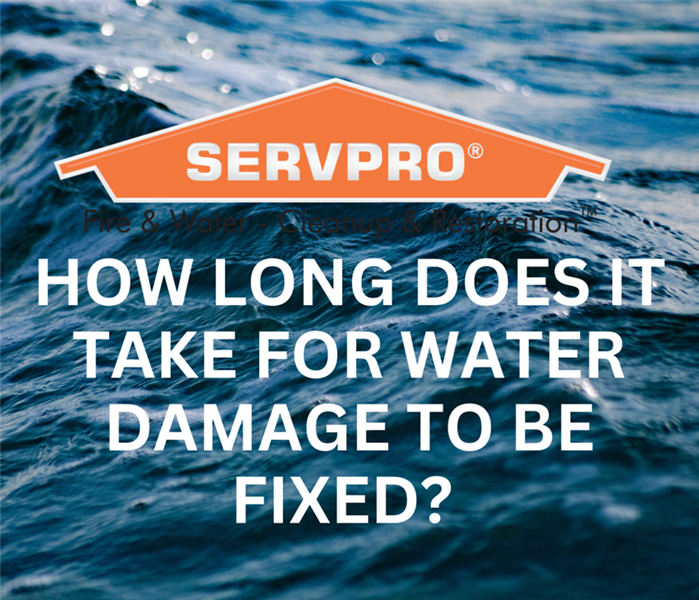 If you experience water damage, contacting a professional restoration company is best to ensure that the damage is fixed properly and efficiently.
If you experience water damage, contacting a professional restoration company is best to ensure that the damage is fixed properly and efficiently.
Water damage is a common problem that many homeowners face. It can be caused by a variety of factors such as leaks, flooding, and burst pipes.
The timeline for fixing water damage depends on the severity of the damage.
- The first step in fixing water damage is to identify the source of the water and stop it from causing further damage. This may involve shutting off the main water supply or fixing a broken pipe. Once the source of the water has been identified and fixed, the water damage restoration process can begin.
- The restoration process typically involves several stages, including water extraction, drying, and repair. The amount of time it takes to complete each stage depends on the extent of the damage.
- Drying is the next stage, and it involves removing any remaining moisture from the affected area. This can be done using dehumidifiers and fans. The duration of this stage depends on the extent of the water damage and the humidity levels in the affected area.
- Once the area has been dried, repairs can begin. This may involve replacing drywall, flooring, and other materials that were damaged by the water. The duration of this stage depends on the extent of the damage and the materials that need to be replaced.
If you experience water damage, it is best to contact a professional restoration company to ensure that the damage is fixed properly and efficiently.
We service Blackstone, Hopedale, Mendon, Milford, Natick, North Natick, and South Natick MA.
SERVPRO Of Natick Milford is The #1 Choice in Cleanup and Restoration for residential and commercial buildings’ fire, mold, water, and storm damage.
What are the steps for water damage in Natick Milford MA?
3/5/2023 (Permalink)
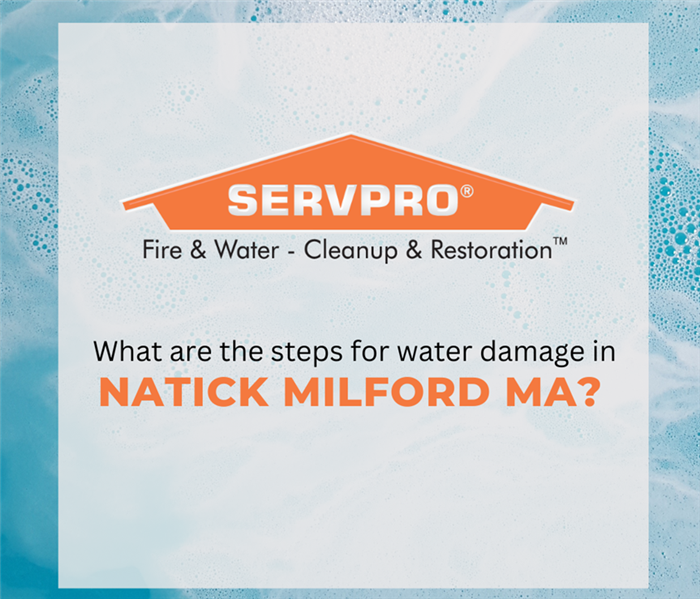 If the damage is extensive, it's best to hire a professional restoration company to ensure your home is restored to its pre-damaged condition.
If the damage is extensive, it's best to hire a professional restoration company to ensure your home is restored to its pre-damaged condition.
Water damage can be one of the most destructive problems a homeowner can face. Whether it's due to a burst pipe, a leaking roof, or flooding, water damage can cause extensive damage to your home, furniture, and personal belongings.
Ensure your safety: The first step in dealing with water damage is to ensure your safety. If the water damage is severe, turn off the electricity, gas, and water supply to your home before entering the affected area.
Document the damage: Before you start cleaning up the water, it's essential to document the damage for insurance purposes. Take pictures and videos of the damage to your home, furniture, and personal belongings.
Remove standing water: The next step is to remove any standing water as quickly as possible. You can use a wet/dry vacuum to remove the water or hire a professional restoration company to do the job for you.
Dry out the affected area: After removing the standing water, the next step is to dry out the affected area. You can use fans and dehumidifiers to speed up the drying process.
Clean and disinfect: Once the affected area is completely dry, it's essential to clean and disinfect the area to prevent mold growth.
Repair and restore: The final step is to repair and restore any damage. This may include replacing drywall, flooring, or furniture.
If the damage is extensive, it's best to hire a professional restoration company to ensure your home is restored to its pre-damaged condition.
We service Blackstone, Hopedale, Mendon, Milford, Natick, North Natick, and South Natick MA.
SERVPRO Of Natick Milford is The #1 Choice in Cleanup and Restoration for residential and commercial buildings’ fire, mold, water, and storm damage.
What Causes Flooding in homes and buildings?
2/15/2023 (Permalink)
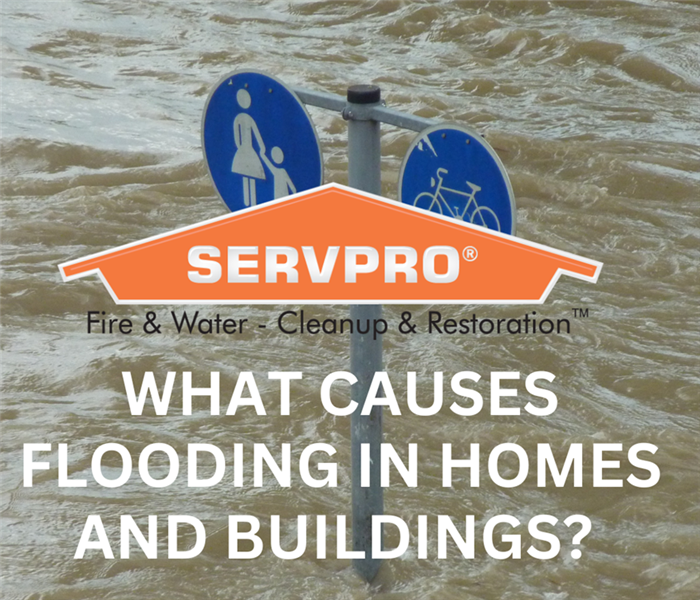 By understanding the causes and impacts of flooding, and implementing measures, we can work to protect our communities.
By understanding the causes and impacts of flooding, and implementing measures, we can work to protect our communities.
Flooding is a natural disaster that occurs when an area is overwhelmed by water, either from heavy rainfall or rising bodies of water.
Causes of Flooding
Flooding can be caused by a variety of factors, including natural events and human activities. The most common natural cause of the flooding is heavy rainfall, particularly during prolonged periods of wet weather. This can lead to rivers and streams overflowing their banks, and low-lying areas becoming flooded.
Flooding can also be caused by rising sea levels, as well as coastal storms and hurricanes. These events can cause significant damage to coastal communities, particularly those in low-lying areas.
Human activities can also contribute to flooding. For example, the construction of buildings and other infrastructure can alter the natural flow of water, leading to increased flooding. Deforestation and other land use changes can also contribute to flooding, as they reduce the ability of soil to absorb water.
Impacts of Flooding
Flooding can have significant impacts on individuals, communities, and economies. The most immediate impact is damage to homes, businesses, and infrastructure, such as roads and bridges. This can result in the displacement of residents, loss of livelihoods, and disruption of essential services.
Flooding can also have long-term impacts on the environment. For example, it can lead to soil erosion, which can reduce the fertility of agricultural land. It can also lead to water pollution, as floodwaters can carry contaminants into rivers and other bodies of water.
Finally, flooding can have significant economic impacts. In addition to the direct costs of repairing damage to infrastructure and homes, flooding can also disrupt supply chains and reduce economic activity in affected areas.
Measures to Mitigate the Effects of Flooding
There are a number of measures that can be taken to mitigate the effects of flooding. One approach is to implement natural solutions, such as restoring wetlands and other natural features that help to absorb and slow down floodwaters. This can help to reduce the impact of flooding on communities and the environment.
Another approach is to implement engineered solutions, such as building flood protection infrastructure like levees, flood walls, and stormwater management systems. These measures can help to prevent flooding in the first place, or to reduce the impact of flooding when it does occur.
It is important to ensure that communities are prepared for flooding. This can involve measures such as developing early warning systems, establishing emergency shelters, and educating residents on how to prepare for and respond to flooding events.
By understanding the causes and impacts of flooding, and implementing measures to mitigate its effects, we can work to protect our communities and reduce the impact of this devastating natural event.
SERVPRO of Natick Milford is your premier choice for fire damage and restoration. Our teams are ready to respond 24 hours a week, any day of the year. When you bring us on the job our team of licensed contractors and certified technicians will work collaboratively with you throughout the duration of the project. They will keep you updated on the project's status and ensure that your expectations are met. We will help you to move forward and make it “Like it never even happened” for all of your fire damage.
SERVPRO of Natick Milford Discusses How To Prevent Flooding in a Basement
2/5/2023 (Permalink)
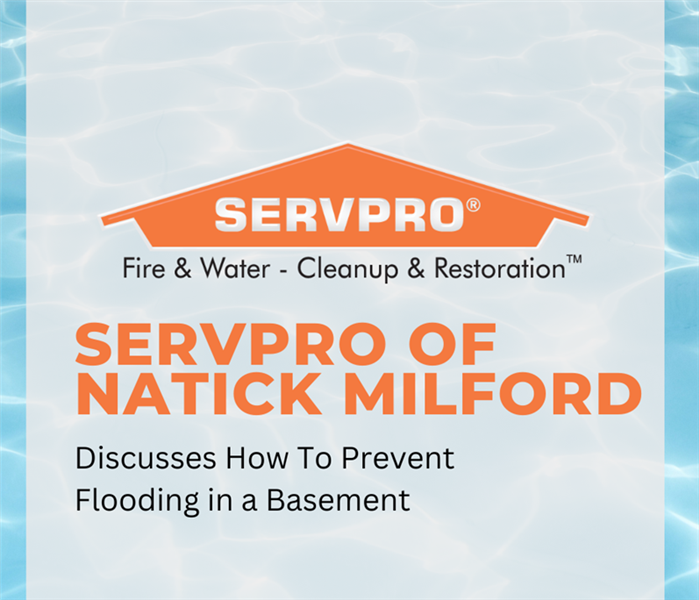 If you do experience basement flooding, don't hesitate to call in a professional to help with the cleanup and repair process.
If you do experience basement flooding, don't hesitate to call in a professional to help with the cleanup and repair process.
Flooding in a basement can be a stressful. It can cause extensive damage to your property and belongings, and if not addressed promptly.
There are many reasons why a basement can flood. Some common causes include:
- Heavy rainfall: When there is an excessive amount of rainfall in a short period of time, it can cause water to seep into the basement through cracks in the foundation, windows, or doorways.
- Overflowing gutters and downspouts: If your gutters and downspouts are clogged, water will overflow and can seep into the basement.
- Sewer backup: A sewer backup occurs when wastewater from the sewer system enters your basement. This can be caused by a blockage in the sewer line, heavy rainfall, or a malfunction in the sewage system.
- High water table: If the water table is high in your area, it can cause water to seep into the basement through the walls or floor.
To prevent basement flooding, there are several steps you can take:
- Install a sump pump: A sump pump is a device that pumps water out of the basement when it reaches a certain level.
- Check your gutters and downspouts regularly: Make sure they are clear of debris and are directing water away from the foundation of your home.
- Install backflow valves: Backflow valves prevent sewer water from flowing back into your home.
- Seal cracks in the foundation: If you find cracks in the foundation of your home, have them sealed to prevent water from seeping in.
If your basement is flooded, it's important to take immediate action to prevent further damage and to mitigate any health risks:
- Turn off the electricity: If water has entered your basement, turn off the electricity to prevent electrical shock.
- Remove water: If the water level is not too high, use a pump or wet vacuum to remove the water. If the water level is too high, call a professional to remove the water.
- Clean and dry everything: Once the water has been removed, clean and dry all the items in the basement. This includes walls, floors, furniture, and other belongings.
- Call in professionals: If the damage is extensive, it's best to call in a professional to assess the damage and make any necessary repairs.
If you do experience basement flooding, don't hesitate to call in a professional to help with the cleanup and repair process.
SERVPRO of Natick Milford is your premier choice for fire damage and restoration. Our teams are ready to respond 24 hours a week, any day of the year. When you bring us on the job our team of licensed contractors and certified technicians will work collaboratively with you throughout the duration of the project. They will keep you updated on the project's status and ensure that your expectations are met. We will help you to move forward and make it “Like it never even happened” for all of your fire damage.
SERVPRO of Natick Milford Shares Causes of a Flooded Basement.
1/7/2023 (Permalink)
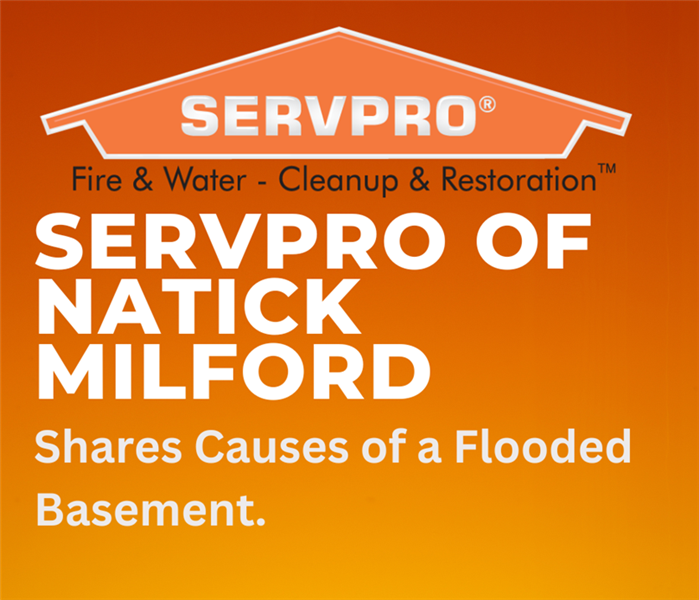 Make sure to check rain gutters and remove all debris, and seal cracks in your foundation to avoid flooding.
Make sure to check rain gutters and remove all debris, and seal cracks in your foundation to avoid flooding.
A flooded basement can occur anytime, especially from weather related events such as heavy rainfall or rapid snowmelt to older homes. There are several reasons why flooded basements can happen.
- Foundation cracks
- Broken basement windows
- Poor-draining window wells
- Sewer system problems
- Sump pump problems
- Improperly sealed basement walls
- House located at the bottom of a slope
- Weeping tile blockage
- Overflowing rain gutters
- Improper downspout locations
- Appliance leaks
- Overflowing toilet or bathtub
- Water heater failure
Make sure to check rain gutters and remove all debris, and seal cracks in your foundation to avoid flooding.
SERVPRO of Natick Milford is your premier choice for water damage and restoration. Our teams are ready to respond 24 hours a week, any day of the year. When you bring us on the job our team of licensed contractors and certified technicians will work collaboratively with you throughout the duration of the project. They will keep you updated on the project's status and ensure that your expectations are met. We will help you to move forward and make it “Like it never even happened” for all of your water damage.
SERVPRO of Natick Milford Shares Frozen Pipe Information
12/5/2022 (Permalink)
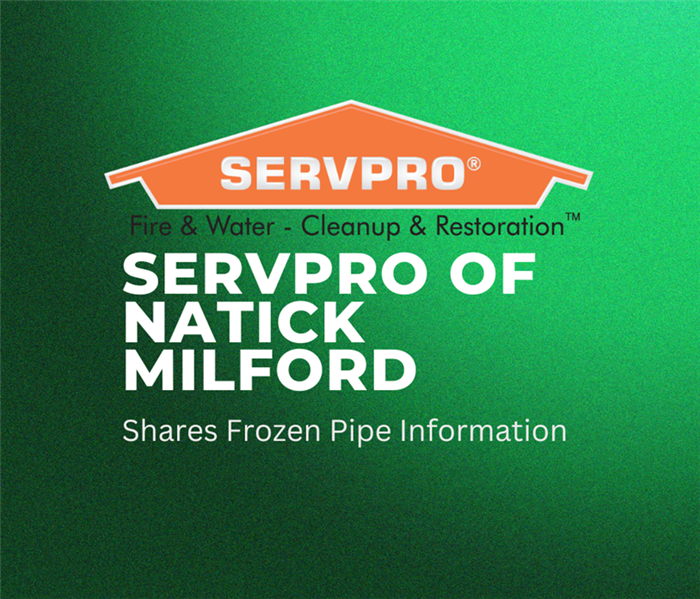 Winter months call for frozen pipes. It is important to know how to prevent pipe damage to your building.
Winter months call for frozen pipes. It is important to know how to prevent pipe damage to your building.
Winter months call for frozen pipes. It is important to know how to prevent pipe damage to your building.
Here is what you should do if you suspect you have frozen pipes.
- Check with a neighbor to see if they’re experiencing frozen pipes too. If they have running water, it’s likely your pipes have frozen.
- Turn off the water immediately using the main shut-off valve.
- Open the faucet for water to flow through the pipe once the area is melted.
- Apply heat around the pipe using a hair dryer. Keep all heat sources away from flammable materials.
- Once pipes are thawed, you can turn the water back on and check all joints for leaks.
- Check all pipes and joints for leaks or cracks.
If there are still issues contact an experienced water restoration company.
SERVPRO of Natick Milford is your premier choice for water damage and restoration. Our teams are ready to respond 24 hours a week, any day of the year. When you bring us on the job our team of licensed contractors and certified technicians will work collaboratively with you throughout the duration of the project. They will keep you updated on the project's status and ensure that your expectations are met. We will help you to move forward and make it “Like it never even happened” for all of your water damage.
SERVPRO of Natick Milford Explains Storm Safety
10/5/2022 (Permalink)
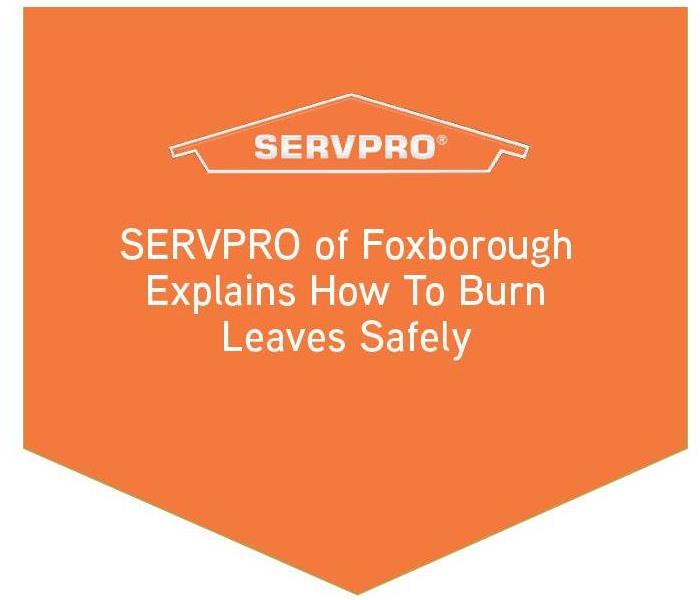 Falling leaves are often the first signs of the fall season. As the piles of raked leaves build up, many are faced with how to dispose of them!
Falling leaves are often the first signs of the fall season. As the piles of raked leaves build up, many are faced with how to dispose of them!
Falling leaves are often the first signs of the fall season. As the piles of raked leaves build up, many are faced with how to dispose of them!
People like to burn leaves or throw trash onto piles, such as household garbage, construction debris, or old papers. This can actually cause more damage than good.
Burning materials such as yard waste, grass clippings, and leaves may be permissible depending on your town’s ordinances. If you decide to burn leaves, do not use flammable liquids to ignite the debris. Keep an eye on the fire at all times and be prepared to extinguish it at any moment. Safety should always be the number one concern.
There are plenty of safe alternatives for you to do instead of burning leaves.
- You can recycle tree limbs, grass clippings, and leaves.
- You can also compost items into mulch or chipped them into landscaping material.
- Many cities and towns provide a curbside collection of bagged leaves. Check with your local public works department.
- Call a yard waste or junk removal service, they will take the debris to the dump or recycling center.
There are plenty of ways to get rid of your leaves this fall, it just depends on what works best for you. Remember safety first; prevent a fire if you are able to.
SERVPRO of Natick Milford is your premier choice for restoration and rebuilding. Our teams are ready to respond 24 hours a week, any day of the year. When you bring us on the job our team of licensed contractors and certified technicians will work collaboratively with you throughout the duration of the project. They will keep you up to date on the status of the project and make sure that your expectations are met. We will help you to move forward and make it “Like it never even happened” for all of your storm damage.
SERVPRO of Natick Milford Shares Water Damage Tips Of What To Do
2/13/2022 (Permalink)
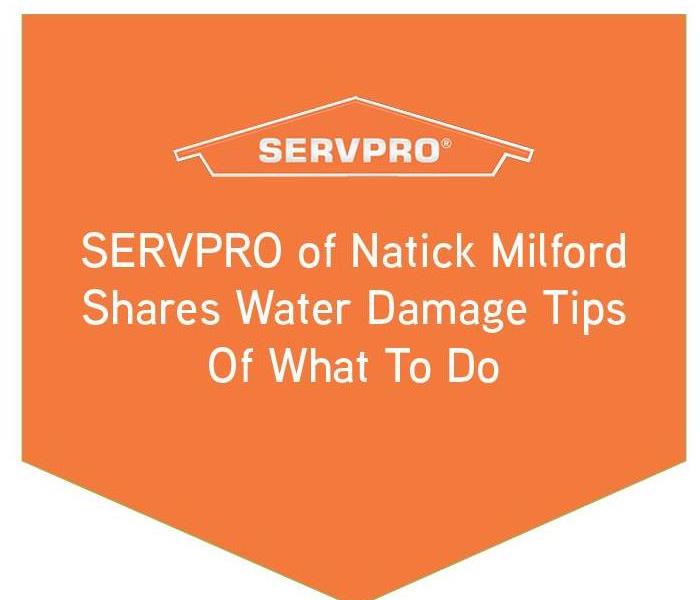 When water damage strikes your property immediate action is crucial, to help prevent further damage.
When water damage strikes your property immediate action is crucial, to help prevent further damage.
When water damage strikes your property immediate action is crucial, to help prevent further damage. Our certified technicians have access to state-of-the-art water extraction and drying equipment to dry your property quickly. We are available 24-7 including all major holidays.
Make sure to call for help immediately. Once you have asked for help here is what you should do while waiting for someone to arrive:
- Remove excess water by mopping.
- Wipe excess water from wood furniture.
- Remove wet upholstery and cushions.
- Place aluminum foil or wood blocks between furniture legs and wet carpeting.
- Turn air conditioning on for maximum drying in summer.
- Remove art objects to a dry place.
- Gather loose items from floors.
The bottom line is that flooding and water emergencies can happen at any time. Rest assured, neither do we! SERVPRO of Natick/Milford provides emergency cleaning and restoration services 24 hours a day, every day of the year, even on holidays.
It is important to not panic if you have water damage. Make sure to take action quickly by calling your local restoration experts and your insurance company.
SERVPRO Natick Milford is available 24/7 including holidays and weekends to assist you and help you with your water damage. “Like it never even happened.”
SERVPRO of Natick Milford shares Water Damage Tips Of What Not To Do
2/13/2022 (Permalink)
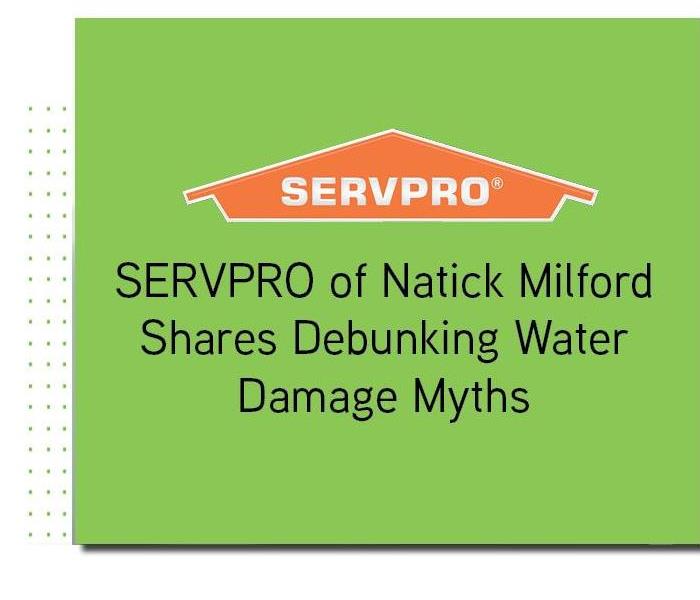 Our certified technicians have access to state-of-the-art water extraction and drying equipment to dry your property quickly and completely.
Our certified technicians have access to state-of-the-art water extraction and drying equipment to dry your property quickly and completely.
Water damage is never any fun, it can be stressful and overwhelming to your property. Our certified technicians have access to state-of-the-art water extraction and drying equipment to dry your property quickly and completely.
There are some steps that you should not take after flooding:
- Do not leave wet fabrics in place.
- Do not leave books or magazines on wet carpet or floors.
- Do not use your household vacuum to remove water.
- Do not use household appliances.
- Do not turn on ceiling fixtures if the ceiling is wet.
If your residential or commercial property suffers water damage, the first step is to turn off the Water Main. Then call the water remediation experts of SERVPRO of Natick/Milford to remediate the water damage.
SERVPRO Natick Milford is available 24/7 including holidays and weekends to assist you and help you with your water damage. “Like it never even happened.”
SERVPRO of Natick Milford Shares Debunking Water Damage Myths
2/13/2022 (Permalink)
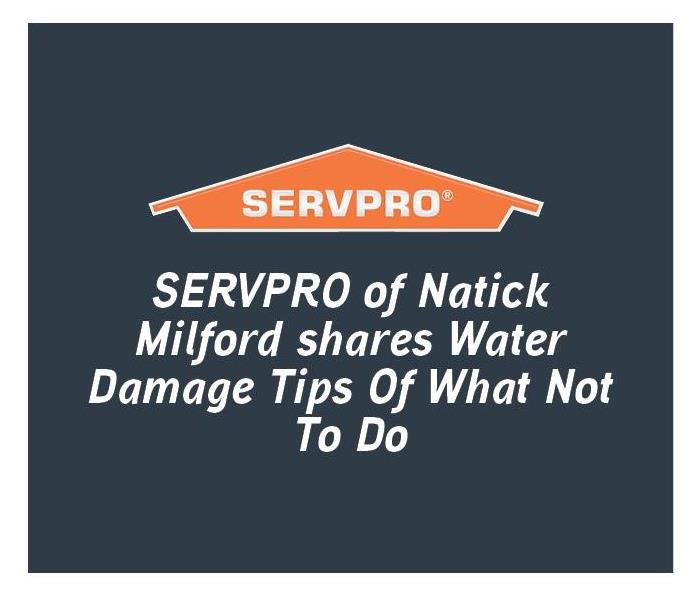 We want to debunk the common myths and educate you on the best ways to prevent water leaks.
We want to debunk the common myths and educate you on the best ways to prevent water leaks.
Water damage can be overwhelming if you do not have experience in this field. Furthermore, people might use resources that share incorrect water damage information.
We want to debunk the common myths and educate you on the best ways to prevent water leaks.
- Water damage won’t happen to me: 1 in 50 insured homes have a property damage claim caused by water damage each year, according to the Insurance Information Institute.
- I’ve already experienced a leak, it won’t happen again: The first leak is less often a one-time event and can lead to another in the future.
- There’s only a leak if I can see it: Leaks aren’t always obvious. Sometimes they look like water spots and other times they’re hidden. Some visible signs of leaks can include: Unexpectedly high water bills, Sagging warped ceilings, Cracked or warped flooring, Mildew or mold in your kitchen, and more.
- If it’s only a small leak, it can wait: It’s easy for small leaks to turn into much larger, since the longer water drips, the worse the damage.
If your residential or commercial property suffers water damage call the water remediation experts of SERVPRO of Natick/Milford to remediate the water damage.
SERVPRO Natick Milford is available 24/7 including holidays and weekends to assist you and help you with your water damage. “Like it never even happened.”
SERVPRO Natick Milford Talks About What to do When Your Basement Floods
1/26/2022 (Permalink)
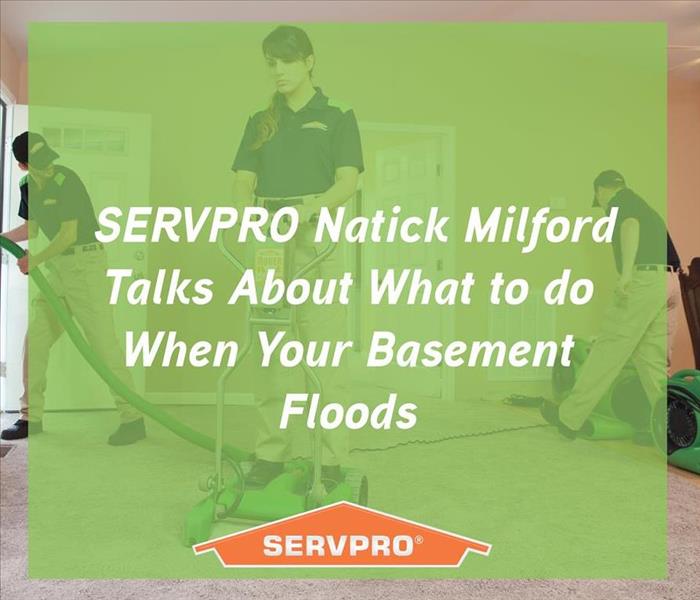 It is important to start the cleanup process quickly when a basement floods. You want to help prevent water damage as much as possible
It is important to start the cleanup process quickly when a basement floods. You want to help prevent water damage as much as possible
It is important to start the cleanup process quickly when a basement floods. You want to help prevent water damage as much as possible, especially to your basement floor. Make sure you and your family stay safe first and foremost.
Here are some simple steps when you're experiencing a flooded basement:
- Call Your Insurance Company: Your homeowner's insurance may cover this kind of extensive damage. Take pictures as soon as you see the damage so you both have a record of the damages.
- Cut Off Power to Your Basement: Do this before checking anything, so you don’t end up getting electrocuted.
- Stop The Source of the Water: Make sure you stop the water at the source to prevent further damage. If a pipe has burst make sure the water main is turned off.
- Pump the Standing Water Out of the Basement: Remove the standing water from your basement. Don’t enter the basement without personal protective equipment, you might get exposed to biohazards that can cause severe illness. If you have damaged, call SERVPRO Natick Milford.
We are ready to respond immediately when you need restoration services for your water. We have the training and equipment for any size disaster, so you and your family can be safe.
SERVPRO Natick Milford is available 24/7 including holidays and weekends to assist you and help you with residential water damage. “Like it never even happened.”
SERVPRO Natick Milford SERVPRO Natick Milford Shares How to Prevent Basement Flooding
1/26/2022 (Permalink)
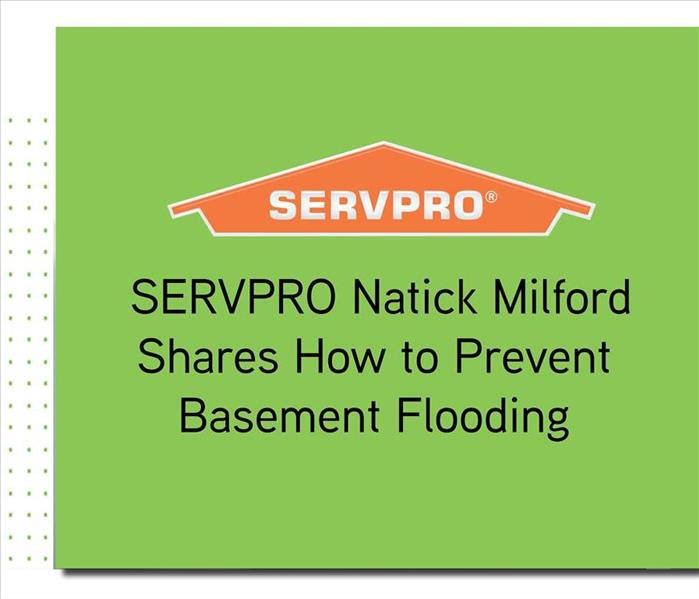 It’s impossible to completely remove all risk of a flooded basement, but you can definitely prevent most basement floods.
It’s impossible to completely remove all risk of a flooded basement, but you can definitely prevent most basement floods.
It’s impossible to completely remove all risk of a flooded basement, but you can definitely prevent most basement floods. Here are some great tips for you to prevent basement flooding.
- Check Gutters: Your gutters should be funneling water six feet away from your foundation. If your gutters are clogged, water may be in your foundation or basement.
- Check for Cracks in Your Foundation: Cracks in the foundation can cause groundwater into your basement after lots of rain or snow.
- Check your Basement Floor Drain: If your basement has this, make sure there isn’t anything blocking your basement floor drain.
- Seal Basement Windows: Your basement windows should be properly installed and sealed. This will help prevent water from leaking inside.
- Invest in a Sump Pump: A sump pump in your basement is the best way to prevent basement flooding. It immediately pumps out any water that goes into the basement.
SERVPRO Natick Milford is available 24/7 including holidays and weekends to assist you and help you with residential or commercial water damage. “Like it never even happened.”
SERVPRO Natick Milford Shares Sump Pump Best Practices
1/25/2022 (Permalink)
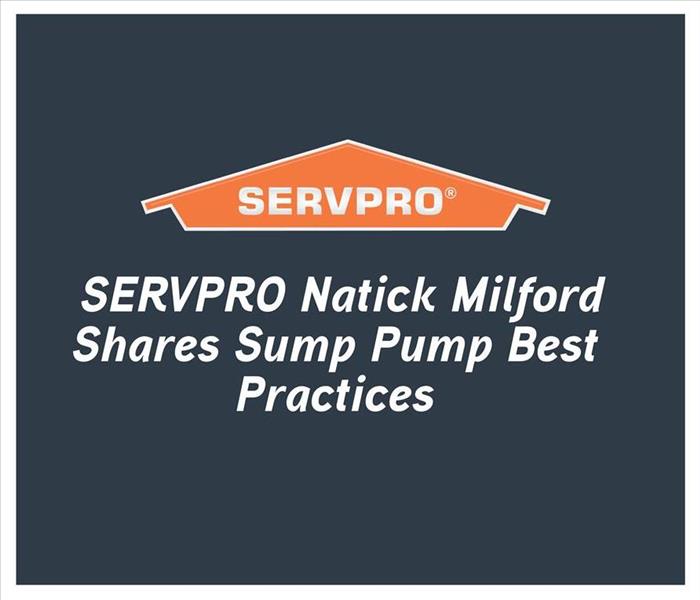 Winter storms can affect many houses and businesses negatively. When the snow melts, the mess can escalate quickly
Winter storms can affect many houses and businesses negatively. When the snow melts, the mess can escalate quickly
Winter storms can affect many houses and businesses negatively. When the snow melts, the mess can escalate quickly; this is where the sump pump comes in.
Sump pumps are cylindrically placed in the lowest point of a basement. If your basement is prone to flooding, it will automatically turn on and pump water from your basement before water damage happens.
They’re placed at the lowest point of your basement. This is because water drains into it. They only turn on when they come in contact with water.
Here are some major sump pump benefits
- Prevents basement flooding
- Protects from sewage backups
- Protects your home from mold and mildew
- Reduces humidity level in the home
- Prevention of termite or insect infestation
Sump pumps remove water from your basement, but they can also pump groundwater away from the basement.
SERVPRO Natick Milford is available 24/7 including holidays and weekends to assist you and help you with residential storm damage. “Like it never even happened.”
HVAC Maintenance
10/16/2021 (Permalink)
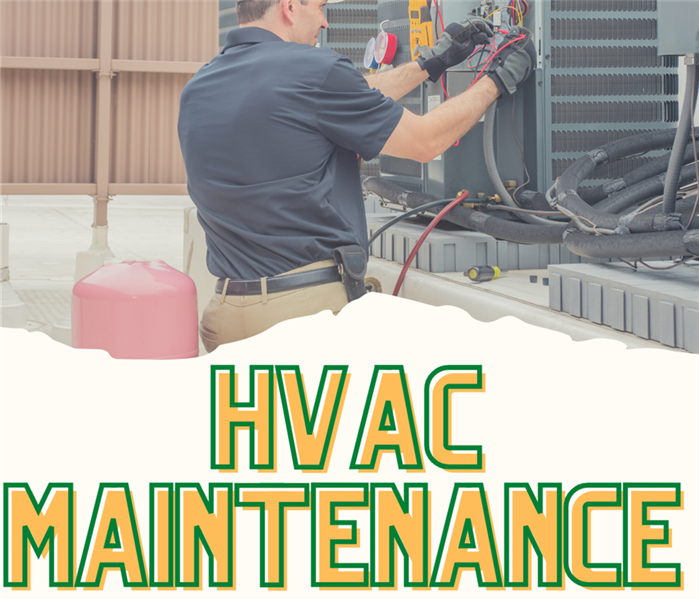 HVAC Maintenance is incredibly important to prevent damage to a home or building.
HVAC Maintenance is incredibly important to prevent damage to a home or building.
HVAC systems are great for keeping your building at a comfortable temperature for the season. Proper ventilation in a home or commercial building is important to keep air fresh and healthy indoors. Although these systems are important to have installed, water or fire damage can often occur from them if they are not maintained. The most common causes of HVAC issues include frozen evaporator coils, clogged drains and pipes that may not be connected properly.
You should always do these simple things to make sure you help to prevent any water damage caused by your HVAC unit.
- Change the HVAC filter regularly
- Clean the condenser
- Maintain the condensation drain line
- Install a condensation pump
- Maintain the overflow drain plan
- And always have your HVAC system inspected professionally
If you have a fire, water, or mold disaster give SERVPRO of Natick/Milford a call today at (774) 290-4300. Our highly trained professionals are ready to help day or night. We are available 24 hours a day, 7 days a week for all of your cleaning and restoration needs.
5 Water Damage Facts
2/26/2021 (Permalink)
Minor Leaks Cause Major Problems.
Preventative maintenance may stop water damage accidents from occurring at your residential or commercial property and if your plumbing is not properly maintained, your insurance may not cover the costs with general wear and tear. If you don't repair or keep an eye on your minor leaks, it may lead to extensive water damage.
Three Types Of Water Contamination
Set up by the IICRC,
- White water or category 1
- Gray water or category 2
- Black water or category 3
White water comes from a sanitary source and poses no threat to people or animals.
Gray water comes from places such as a washing machine or a dishwasher. There is some level on contamination within these machines that have the potential to harm animals or humans.
Black water is the most malicious of the categories because this category often results from flood water or sewage posing the largest threat to humans and animals.
Time Is Your Enemy
The longer that water is sitting in your residential or commercial property the more issues will arise. Water damage is extremely invasive and gives no care in the world about personal space. Seeping in the cracks and crevices, water that sits in one spot can damage drywall, mold and mildew may spread, and paint can blister.
Water Damage Is Not Always Visible
Moisture can hide within the walls, underneath floors, and hard to reach areas allowing the opportunity for mold to grow. Given the right circumstances, mold can grow as soon as 24-48 hours. It is pertinent that mold be taken care of right away as it can spread rapidly, causing an upward spike in your costs.
Multiple Materials Equals Multiple Cleaning Protocols
Water damage can be tricky. Depending on the extent of the damage and the affected materials, not all items may be salvageable. Concrete and harder surfaces can normally be fixed whereas soaked drywall, ceiling tiles, and insulation may need to be tossed. The Disaster Remediation Teams at SERVPRO of Natick/Milford have, whenever appropriate, a restore before replace mentality to lower your overall time to recovery and recovery costs.
No matter how hard you try, a water damage disaster is never 100% preventable. SERVPRO of Natick/Milford wants you to be as prepared as possible if a disaster takes place and know that we are here to help. When your residential or commercial property has water damage call the water remediation experts of SERVPRO of Natick/Milford to remediate the water damage. and to determine the cause of the burst pipe at (774) 290-4300. We will make it, "Like it never even happened."
Signs Of Water Damage To Your Foundation
2/23/2021 (Permalink)
Foundation water damage weakens the structure of your commercial or residential property causing cracks in drywall, walls to bow, and let water into your basement. Getting a head of the curve is key to mitigating damage and cost of repair. Here are some early signs of foundation water damage:
Cracks
Cracks may appear on both the interior and exterior of a foundation and are a tell-tale sign of water problems. On the exterior, a few hairline cracks aren't normally a concern. It is important to be aware of horizontal cracks and stair-step cracks in block walls or corners. This may indicate serious structural damage and you should consult a water damage professional like the experts at SERVPRO of Natick/Milford.
Standing Water
Water in a basement or crawl space could be an indication of a plumbing issue, however it could also mean that there is water seeping in through cracks in the foundation or gutter runoff. Either way, they're both causing issues and should be addressed immediately. Seeping water is a perfect host for mold growth and can weaken wooden support structures.
Windows And Doors Sticking
Excess water absorption in a building can cause frames to warp, which means that there is probably a waterproofing problem. Excess outside moisture can also cause your entire foundation to shift, leading to much bigger issues that will need to be addresses.
Flooded Soil
If your gutters or other drainage systems are not doing their job properly, it can cause water to redirect back to your foundation instead of away from your house. If you see pools of water around your home, the wet soil will increase the likelihood that water will penetrate the foundation of your home.
If your residential or commercial property has any of the above signs of water damage call the water remediation experts of SERVPRO of Natick/Milford to remediate the water damage. and to determine the cause of the burst pipe at (774) 290-4300. We will make it, "Like it never even happened."
Water Damage Misconceptions
2/16/2021 (Permalink)
Water damage can catch you off guard. If not taken care of immediately to avoid secondhand damage. Here are six myths that about water damage;
Not Covered By Insurance
Many times people believe that if their residential or commercial property a small flood, the money used to clean up and repair the damages will come straight from their pockets. This is not always true. Although it's very important to be on top of your homeowner's insurance, in most cases it will cover the damages. Each situation is unique but we will work with your insurance company to get you the best, cost effective coverage.
Water Will Dry Naturally
The water that you can see with your own eyes will surely dry, but water will also seep into your walls and underneath your flooring. If you do not take care of the hidden materials that are wet, moisture can lead to the formation of mold. Mold remediation is more complicated and can lead to higher expenses. SERVPRO of Natick/Milford has state-of-the-art industrial strength equipment to dry structures completely, eliminating the risk of secondary damage.
It Will Be Odorless
Water damaged areas will begin to smell if they are not properly and completely dried out AND treated with an antimicrobial. Not only does mold have an unpleasant odor but it can also cause health effects. Our certified technicians follow a standard procedure to clean, disinfect, and sanitize a wide variety of materials.
It Can Wait
WRONG! The window between water damage and the growth of mold is extremely short. Also, the longer building materials remain moist the greater the risk of structural damage to you property. The second that water hits any surface there is a risk for extensive damage. Even the smallest of water damage situations can lead to serious complications.
My Wood Floors Are Ruined
SERVPRO of Natick/Milford has a wide variety of equipment to handle water and our injectiDRY system includes a mat floor drying system. It is designed specifically to handle damages on precious flooring to dry them out safely and efficiently. Not only do you avoid having to pay for new flooring, but the drying process is expedited.
If I Can Not See The Water, It Is Not There.
Hidden water is the greatest cause of secondary property damage. Water that gets behind your walls will saturate your insulation decreasing its effectiveness and may result in mold infestation. Water can get under flooring and rugs and into the subflooring ruining the integrity of the floor. Even elevated levels of humidity are dangerous as that will create the ideal environment for mold growth.
If your residential or commercial property suffers water damage the first step, if it is safe to do so, is to turn off the Water Main. Then call the water remediation experts of SERVPRO of Natick/Milford to remediate the water damage. and to determine the cause of the burst pipe at (774) 290-4300. We will make it, "Like it never even happened."
Dealing With A Sewage Backup
2/1/2021 (Permalink)
Water damage to your Natick, Ma commercial or residential property can be absolutely devastating. Water from sewer system backups should be considered very dangerous. The water is grossly unsanitary and may contain bacteria and viruses that could cause serious illness. Special training and equipment is necessary to safely clean this type of contamination.
If you ever face a sewage backup in your property, there are a few things that are helpful to know to speed proper cleanup and ensure a safe and sanitary recovery.
Here To Help
If you suspect you have damaged sewer lines, call your sewage company to schedule an inspection. To protect your property from future mold or rot issues after a toilet overflow, call flood damage remediation experts of SERVPRO of Natick/Milford. Only with the help of professional water removal specialists can you rest assured that floodwater has not crept into places you cannot see to wreak havoc.
Dry The Area
Though you may be tempted to sanitize immediately after a toilet overflows, you should not do so before you start drying out the affected area. Whether you are dealing with a flooded toilet or an entire flooded basement, the first thing you should do is utilize heavy duty vacuums, drainage systems and fans to remove all the water.
Sanitize
After drying the area, sanitize it as best you can. Floodwater resulting from sewer damage can be toxic, so be thorough in your cleaning processes. Once the area is dry from the first round of sanitizer, you should plan to disinfect it one more time.
Dehumidify
The presence of excess water in a bathroom often welcomes lingering humidity, which only encourages mold growth in spaces affected by sewer water. During the process of drying, sanitizing, and restoring, a dehumidifier should always be running.
If you experience a sewage backup the first step, if it is safe to do so, is to turn off the Water Main. Then call the water remediation experts of SERVPRO of Natick/Milford to remediate the water damage. and to determine the cause of the burst pipe at (774) 290-4300. We will make it, "Like it never even happened."
How To Prevent Frozen Pipes
1/21/2021 (Permalink)
When temperatures plummet, the risk of your pipes freezing and bursting increases. In fact, burst pipes are one of the most common causes of property damage during frigid New England winters and the cost to repair the damage resulting from burst pipes can be thousand of dollars.
The pipes most at risk are those in unheated interior spaces such as basements, attics, and garages. Still, even pipes running through cabinets or exterior walls can freeze. The good news is there are some simple things you can do to keep your water running and your house dry.
How To Beat The Freeze
Once the temperature starts dropping outside, you should take measures inside to keep your pipes warm and water running. Research shows that the “temperature alert threshold” is 20° F, especially if you have uninsulated pipes running through an uninsulated space. Here are some preventative steps property owners can take to reduce the risk of pipes freezing in their Mendon, Ma commercial or residential property.
- If there are water supply lines in the garage keep the garage doors closed
- Open kitchen and bathroom cabinet doors to allow warmer air to circulate around the plumbing, especially if your sinks are on an exterior wall
- Let the cold water drip from a faucet served by exposed pipes—even at a trickle, running water through pipes helps prevent them from freezing
- Keep the thermostat set to the same temperature during day and night
- If you plan to be away during cold weather, leave the heat on in your home, set to a temperature no lower than 55° F
- Insure attics, basements, and crawl spaces are properly insulated
How To Safely Thaw Frozen Pipes
If you turn on a faucet and only a trickle comes out, you may well have a frozen pipe. It is important to be careful when thawing frozen pipes. The frozen water in your pipes may be blocking any bursts and once the ice melts water will come flowing out and flood your property.
The first thing to do if you suspect that your pipes have frozen is to turn off the water at the main shutoff valve.
- If you are unable to locate the frozen area, if the frozen area is not accessible, or if you cannot thaw the pipe call a plumber
- If the water is still running, you are able to locate the frozen area, the frozen area is accessible and you are certain that the pipes have not burst, you can take the following steps:
- Turn on the faucet.
- Apply heat to the section of pipe using an electric heating pad wrapped around the pipe, an electric hair dryer or by wrapping pipes with towels soaked in hot water
- DO NOT use a blowtorch, a kerosene or propane heater, a charcoal stove, or any device with an open flame as you may start a fire
- Apply heat until full water pressure is restored. Check all other faucets in your home to see whether you have additional frozen pipes. If one pipe freezes, others may freeze, too
- If you cannot thaw the pipe call a plumber
If you experience a burst pipe, the first step, if it is safe to do so, is to turn off the Water Main. Then call the water remediation experts of SERVPRO of Natick/Milford to remediate the water damage. and to determine the cause of the burst pipe at (774) 290-4300. We will make it, "Like it never even happened."
Water Damage Do's And Don'ts
1/21/2021 (Permalink)
When water damage strikes your Holliston, MA residential or commercial property immediate action is crucial. That is why the Disaster Remediation Teams of SERVPRO of Natick/Milford are on call 24 hours a day, every day of the week, including holidays! Our certified technicians have access to state-of-the-art water extraction and drying equipment to dry your property quickly and completely.
After making the call there are some steps that you can take to help accelerate the process as well as those to avoid to stay out of harm's way.
What To Do After Flooding
- Remove excess water by mopping and blotting.
- Wipe excess water from wood furniture after removal of lamps and tabletop items.
- Remove and prop wet upholstery and cushions.
- Place aluminum foil or wood blocks between furniture legs and wet carpeting.
- Turn air conditioning on for maximum drying in summer.
- Remove colored rugs from wet carpeting.
- Remove art objects to a safe, dry place.
- Gather loose items from floors.
What NOT To Do After Flooding
- Do not leave wet fabrics in place. Hang furs and leather goods.
- Do not leave books, magazines or other colored items on wet carpet or floors.
- Do not use your household vacuum to remove water.
- Do not use television or other household appliances.
- Do not turn on ceiling fixtures if the ceiling is wet, and keep out of rooms where ceilings are sagging.
If your residential or commercial property suffers water damage, the first step, if it is safe to do so, is to turn off the Water Main. Then call the water remediation experts of SERVPRO of Natick/Milford to remediate the water damage. and to determine the cause of the burst pipe at (774) 290-4300. We will make it, "Like it never even happened."
 Water damage can happen without warning, leaving your home or business at risk of serious and lasting harm if not addressed quickly.
Water damage can happen without warning, leaving your home or business at risk of serious and lasting harm if not addressed quickly.




 24/7 Emergency Service
24/7 Emergency Service































